British Columbia is home to an incredible variety of birds, including hundreds of species that are found nowhere else in Canada.
From the soaring bald eagles that patrol the rugged coastline to the tiny Anna’s hummingbirds that flit through suburban gardens, the province’s avian diversity is a testament to the richness and complexity of its ecosystems.
Whether you’re an experienced birder or simply an admirer of wildlife, BC’s birdlife is certain to leave you awe-struck and inspired.
In this article, we will explore some of the most fascinating and iconic birds of British Columbia, and discover why this province is such a special place for avian enthusiasts.
1. Rock Dove
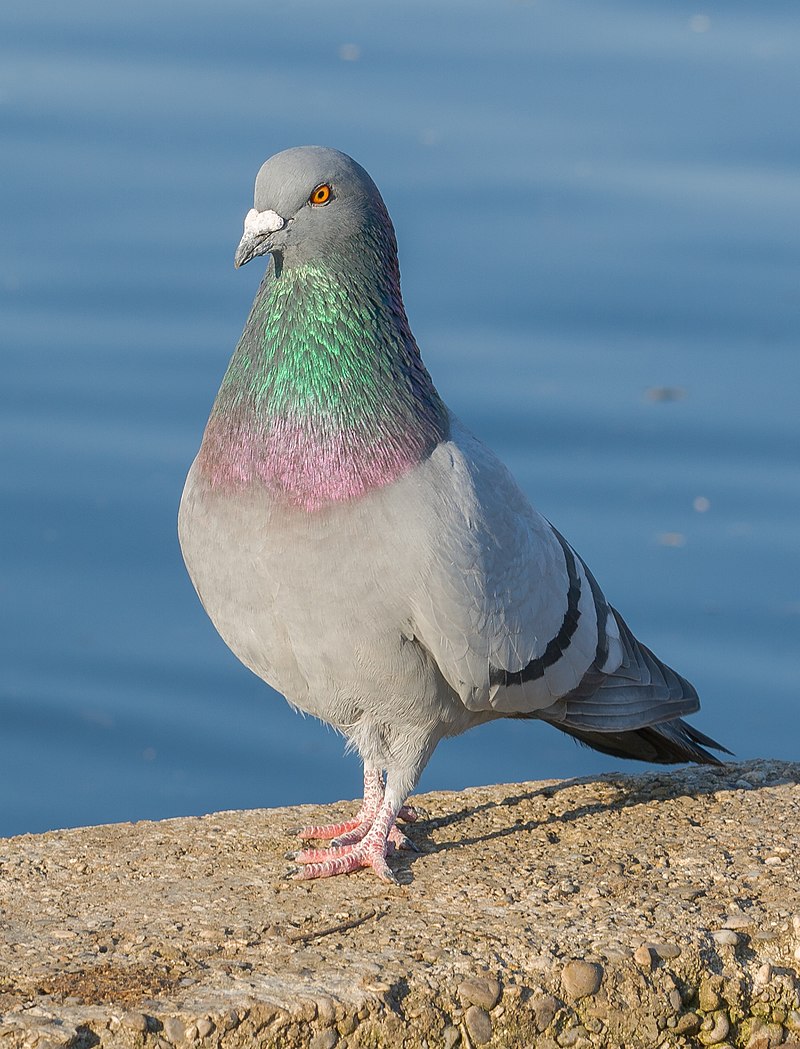
Rock dove, also known as Rock Pigeon or Common Pigeon, is a member of the bird family Columbidae.
It is considered to be an important creature worldwide due to its domestication by humans centuries ago; resulting in the modern-day Domestic pigeon which descends from this species.
Its population has increased over time because some domestic pigeons have escaped captivity and joined wild populations.
The rock dove can most easily be identified by its prominent blue-grey feathers with darker bars on the wings and tail along with two black bands on each wing.
They are typically found in large flocks near cliffs or buildings but may also inhabit rural habitats such as open fields and meadows if there’s enough food available for them nearby.
Although they don’t migrate far distances like other birds, their numbers increase significantly during winter months.
When more food sources become available close by they won’t need to travel too far away from their home base for nourishment.
Scientific classification:
| Kingdom | Animalia |
| Phylum | Chordata |
| Class | Aves |
| Order | Columbiformes |
| Family | Columbidae |
| Genus | Columba |
| Species | C. livia |
Also Featured In: Common Birds in India, Italian Birds You Should Know
2. Thrush
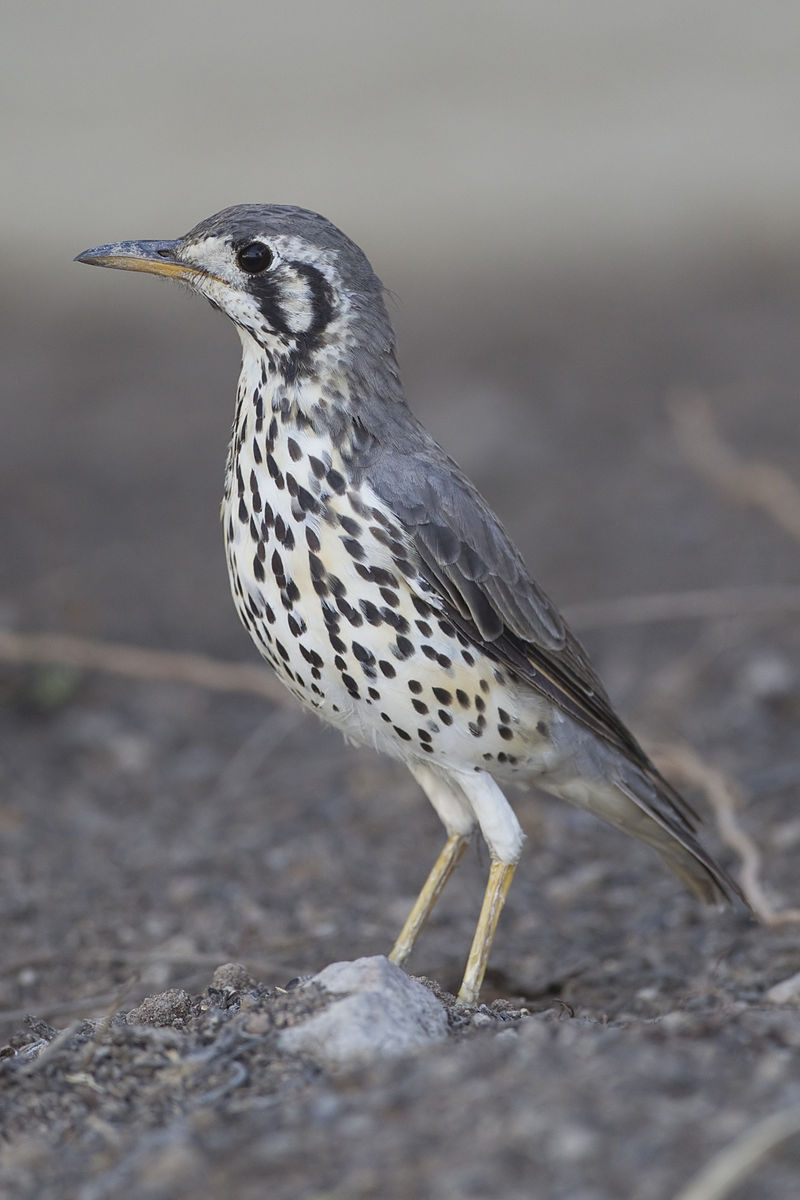
Thrushes are small to medium-sized birds belonging to the Turdidae family and found all over the world. They live on or near the ground and feed on insects, other invertebrates and fruit.
Their feathers range from greyish browns to deep blues in color with spotted wings that help them blend into their natural habitats such as forests, woodlands and shrubs.
Thrushes have distinctive songs that they sing during spring mating season; many species also perform complex flight displays for courtship rituals.
These birds may be solitary creatures but can often be seen foraging together in groups or pairs when searching for food sources like worms, snails or berries.
A healthy thrush population is an indication of a balanced environment since they require clean water sources as well as plenty of vegetation cover – making them important indicators of ecosystem health worldwide.
Scientific classification:
| Kingdom | Animalia |
| Phylum | Chordata |
| Class | Aves |
| Order | Passeriformes |
| Suborder | Passeri |
| Family | Turdidae Rafinesque, 1815 |
Also Featured In: Most Common Songs Birds that Live around You, Most Common Romanian Birds
3. American Robin

The American robin is a migratory bird, belonging to the true thrush genus and Turdidae family.
It was named after its European counterpart due to the similar reddish-orange breast they both possess; however, they are not related closely.
This species can be seen through most of North America during winter months, as well as in parts of Mexico and Central America where it also breeds.
They have plump bodies with gray upperparts and white underparts that vary from yellow on their throats down to orange toward their bellies.
Robins feed on fruits such as berries or insects like worms which makes them an important part of ecosystems by helping disperse seeds naturally throughout these areas.
Scientific classification:
| Kingdom | Animalia |
| Phylum | Chordata |
| Class | Aves |
| Order | Passeriformes |
| Family | Turdidae |
| Genus | Turdus |
| Species | T. migratorius |
Also Featured In: Most Common United States Birds, Most Common Winter Birds
4. American Goldfinch
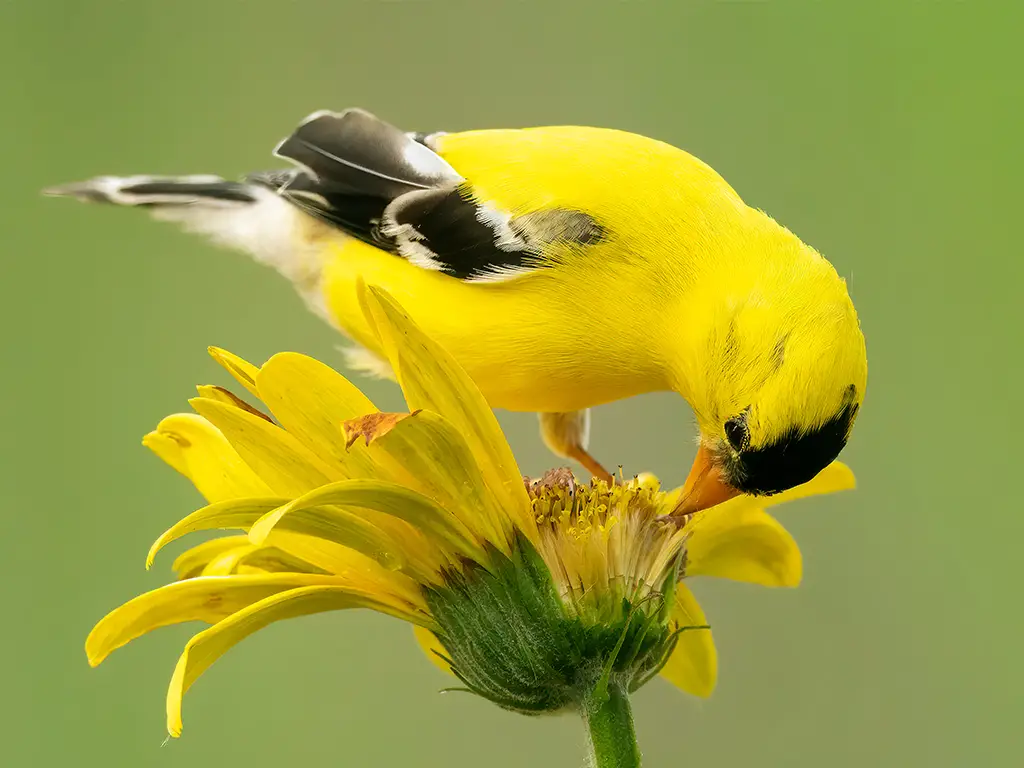
The American goldfinch is a small North American bird in the finch family. Males are vibrant yellow with black wings and tails, while females are duller in coloration.
It migrates from mid-Alberta to North Carolina during the breeding season, south of Canada–United States border to Mexico for its wintering grounds.
The only finch which undergoes complete molt every year displays sexual dichromatism where males have brighter colors than their female counterparts.
They feed mainly on seeds but also eat insects such as aphids and caterpillars when raising young; they often occur near thistles or other plants that produce viable seed heads.
Their call consists of an array of chirps and trills making them quite conspicuous.
Scientific classification:
| Kingdom | Animalia |
| Phylum | Chordata |
| Class | Aves |
| Order | Passeriformes |
| Family | Fringillidae |
| Subfamily | Carduelinae |
| Genus | Spinus |
| Species | S. tristis |
Also Featured In: Common Southern Californian Birds, Common Central Park Birds
5. Black-Capped Chickadee
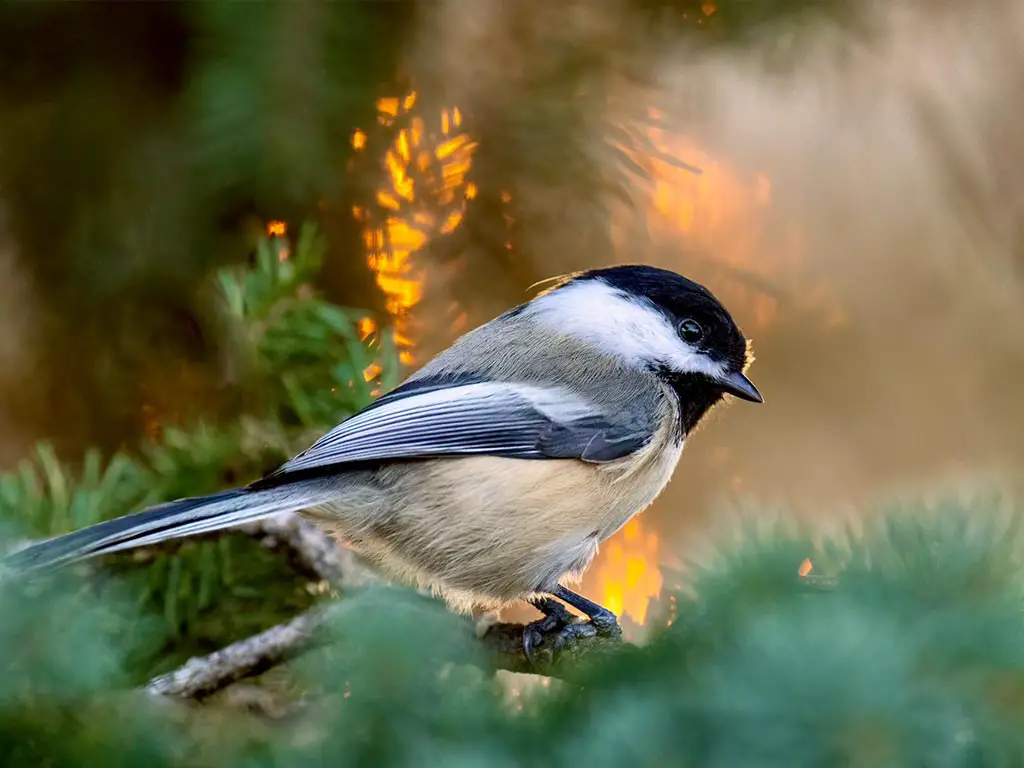
The black-capped chickadee is a small and cheerful songbird found in deciduous and mixed forests across North America. It has an iconic black cap, white cheeks, gray back, and wings with whitish bars on them.
The underparts are usually light-colored or greyish-brown. This species is well adapted to cold winters as it can reduce its body temperature by up to 8°C while roosting at night; this helps save energy during the colder months of the year.
It feeds mainly on insects but also eats seeds, fruits, and suet from bird feeders when available.
Black-capped chickadees are popular birds among backyard visitors due to their sociable nature – they often establish lifelong partnerships with one another for breeding purposes.
Furthermore, they have been designated as state birds of Massachusetts and Maine in the USA plus New Brunswick in Canada – a testament to how beloved these little avian friends truly are.
Scientific classification:
| Kingdom | Animalia |
| Phylum | Chordata |
| Class | Aves |
| Order | Passeriformes |
| Family | Paridae |
| Genus | Poecile |
| Species | P. atricapillus |
Also Featured In: Common Birds in the Cities, Summer Birds that Live around Us
6. Common Loon
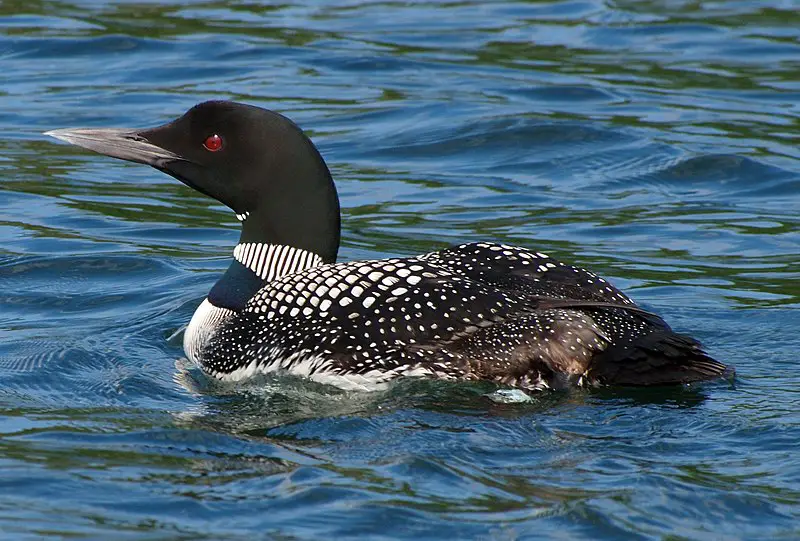
The Common Loon is a beautiful bird found in North America. It has a large black head and neck, with a greenish to purple sheen that stands out against its dark grey upperparts.
The underparts are pure white except for some black on the undertail cover and vent.
During non-breeding season adults have brown plumage instead of the bright shades they show during breeding season.
They also exhibit unique behaviors such as diving underwater to catch fish or swimming along lakeshores while calling loudly, which is how they got their name “great northern diver”.
With their stunning colors and interesting behavior, it’s no wonder why these birds make up an iconic part of many landscapes across North America.Scientific classification:
| Kingdom | Animalia |
| Phylum | Chordata |
| Class | Aves |
| Order | Gaviiformes |
| Family | Gaviidae |
| Genus | Gavia |
| Species | G. immer |
Also Featured In: Shetland Islands Birds You Should Know, Birds that Live in Greenland
7. New World Warblers

New World warblers are an incredibly diverse family of small birds found only in the Americas. They range in size from tiny hummingbirds to large thrushes and come in a variety of vibrant colors.
All have thin bills made for eating insects which form their main diet. Most species live predominantly arboreal lives, meaning they spend most of their time among trees or bushes searching for food.
However, some members such as ovenbirds and waterthrushes prefer more terrestrial habitats like forest floors where they can scavenge for bugs on the ground instead.
Warblers provide a great source of entertainment with their beautiful songs often filling up woodlands during mornings and evenings throughout springtime.
Scientific classification:
| Kingdom | Animalia |
| Phylum | Chordata |
| Class | Aves |
| Order | Passeriformes |
| Superfamily | Emberizoidea |
| Family | Parulidae Wetmore et al., 1947 |
Also Featured In: Common Denmark Birds, Autumn Birds You Should Know
8. Downy Woodpecker
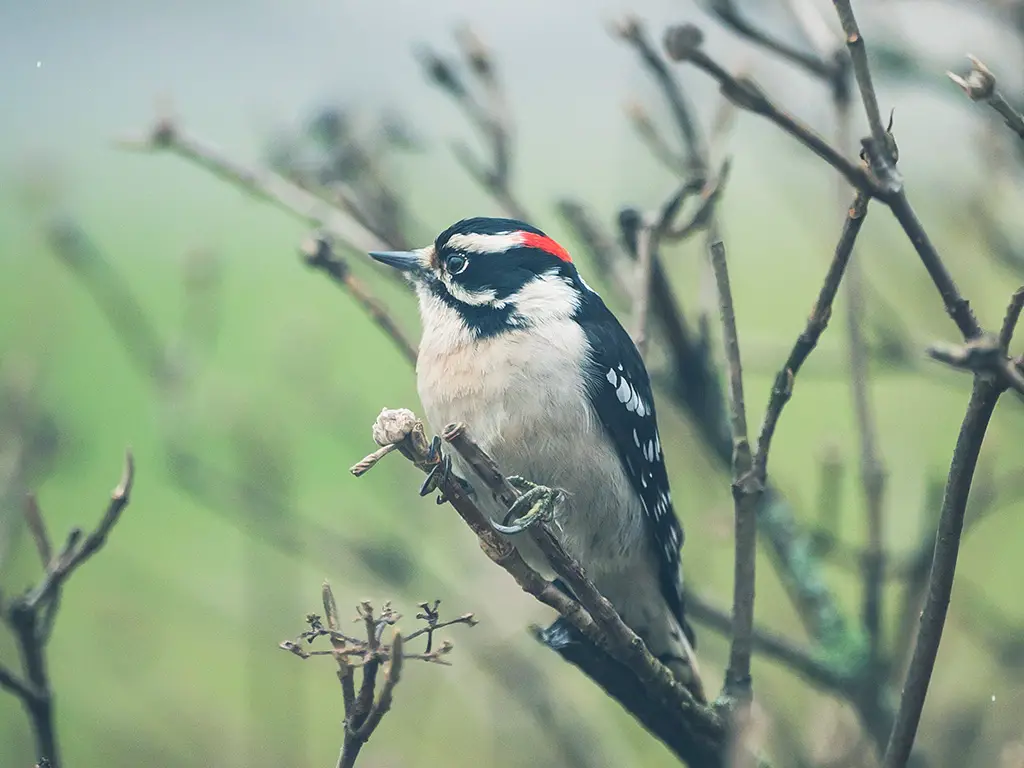
The downy woodpecker is a small species of woodpecker found in North America. Growing up to 7 inches long, it can be identified by its white belly and spotted wings.
It inhabits forests throughout the United States and Canada, except deserts in the southwest and northern tundra.
This bird nests in tree cavities and feeds mostly on insects but will supplement its diet with fruit or nuts when available.
The Downy Woodpecker has an unmistakable call that sounds like a loud ‘piker’, similar to other members of its family such as the Hairy Woodpecker.
Scientific classification:
| Kingdom | Animalia |
| Phylum | Chordata |
| Class | Aves |
| Order | Piciformes |
| Family | Picidae |
| Genus | Dryobates |
| Species | D. pubescens |
Also Featured In: Long Island Birds You Should Know, Common Birds in Saskatchewan
9. American Crow

The American crow is a large bird of the Corvidae family, native to most parts of North America.
It is similar in size and structure to its European counterpart, the carrion crow, as well as Eurasia’s hooded crow.
The three species occupy the same ecological niche but are distinguishable by their differences in appearance.
American crows have black feathers covering their entire body with wingspan averaging between 17-21 inches wide for males and 16-19 inches for females.
They feed on insects such as grasshoppers, beetles, and caterpillars; they also eat grains from fields or abandoned farms during winter months when food sources become scarcer.
In addition to feeding habits, American crows can be identified by their distinct call which resembles a “caw” sound that travels long distances over open terrain making them popular among birdwatchers.
Scientific classification:
| Kingdom | Animalia |
| Phylum | Chordata |
| Class | Aves |
| Order | Passeriformes |
| Family | Corvidae |
| Genus | Corvus |
| Species | C. brachyrhynchos |
Also Featured In: Birds Live Near San Diego, Birds that Live in San Francisco Bay Area
10. House Sparrow

The house sparrow is a small bird of the Passeridae family. It has an average length of 16 cm and weighs 24-39.5 gm.
Females have dull brown and grey plumage, whereas males are brighter, with black, white, and brown markings on their wings and back feathers.
This species is one among 25 different kinds in its genus Passer. These birds are found all around the world mainly near human dwellings where they feed off food scraps from garbage bins or gardens etc..
They also make nests close to houses which makes them even more visible to people living nearby.
House sparrows can be seen hopping around yards looking for food during daytime hours but usually hide in colonies at night time.
Scientific classification:
| Kingdom | Animalia |
| Phylum | Chordata |
| Class | Aves |
| Order | Passeriformes |
| Family | Passeridae |
| Genus | Passer |
| Species | P. domesticus |
Also Featured In: Birds for Your Home Garden, Ukrainian Birds You Should Know
11. House Finch

The House Finch is a species of finch native to western North America and has been introduced in the eastern half of the continent as well as Hawaii.
It’s an average-sized finch with adults measuring 12.5 – 15 cm (5 – 6 inches) long and having wingspans between 20 – 25 cm (8 – 10 inches).
The upperparts are brown, while its underparts range from pale grayish white to yellow depending on subspecies.
Its face is streaked or spotted with reddish coloration; males typically have brighter plumage than females due to sexual dimorphism.
They’re mostly found near human habitations such as farms and gardens where they feed on grains, fruits, insects etc., making them very popular among birders who want something colorful for their backyard.
Scientific classification:
| Kingdom | Animalia |
| Phylum | Chordata |
| Class | Aves |
| Order | Passeriformes |
| Family | Fringillidae |
| Subfamily | Carduelinae |
| Genus | Haemorhous |
| Species | H. mexicanus |
Also Featured In: Common Birds That Live in Las Vegas, Birds that Migrate through Illinois in the Spring
12. Dark-Eyed Junco

The Dark-eyed Junco is a species of small, grayish sparrows that are found across much of temperate North America and in the Arctic during summer.
It was formally described by Carl Linnaeus in 1766, who named it after its distinctive dark eyes.
This bird has a very variable appearance due to the many different subspecies it contains, making its systematics difficult to unravel.
The plumage varies from white or light gray on their underparts with slate grey backs and wings; black heads with white outer tail feathers; brown head stripes; yellow bills; pink legs and feet; as well as various shades between all these colours.
They also have considerable sexual dimorphism where males tend to be more colorful than females but share similar characteristics such as short tails and rounded bodies – both sexes being around 16 cm long when fully grown.
Scientific classification:
| Kingdom | Animalia |
| Phylum | Chordata |
| Class | Aves |
| Order | Passeriformes |
| Family | Passerellidae |
| Genus | Junco |
| Species | J. hyemalis |
Also Featured In: Lake Tahoe Birds, Common Birds in Alberta
13. Common Starling

The Common Starling is a medium-sized passerine bird that belongs to the Starling family. It has glossy black plumage with a metallic sheen, and at certain times of year it can be speckled with white.
The bill and legs are typically pink or black depending on the season, while its length measures about 8 inches long.
Its diet consists mainly of insects but also includes small fruits and seeds as well as some human food waste.
They live in large flocks which protects predators, although they can become quite aggressive when defending their nesting sites during breeding seasons.
Overall, this species is highly adaptable and widely distributed across many parts of Europe making them one of the most successful birds in the region today.
Scientific classification:
| Kingdom | Animalia |
| Phylum | Chordata |
| Class | Aves |
| Order | Passeriformes |
| Family | Sturnidae |
| Genus | Sturnus |
| Species | S. vulgaris |
Also Featured In: Flocks Birds around Us, European Birds
14. Mourning Dove
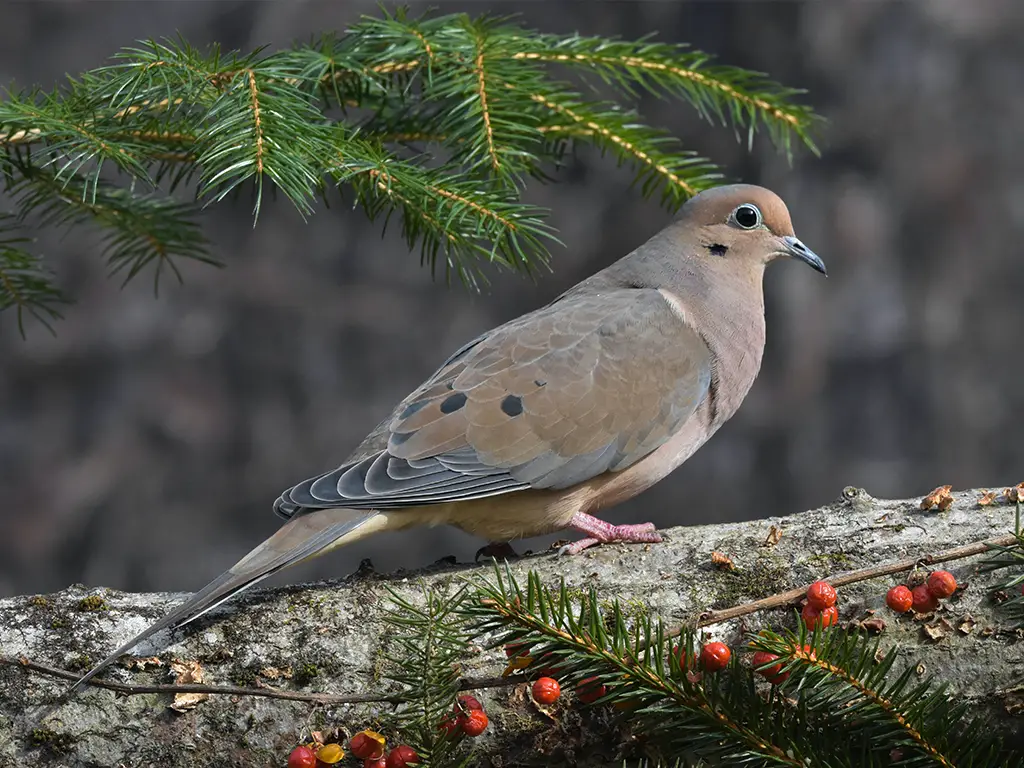
The Mourning Dove is a breathtakingly beautiful bird. It has stunning gray and brown feathers with white-tipped wings, giving it an elegant appearance. Its long tail also adds to its graceful look in flight.
A symbol of peace and serenity, they are abundant across North America and can be found in gardens or open fields throughout the year.
As well as being popular game birds for hunters, they feed on grains such as wheat and millet providing important food sources for wildlife species including foxes, coyotes, skunks, and raccoons.
These doves have a distinctive cooing sound that can often be heard echoing through woodlands during summer evenings making them one of nature’s greatest treasures.
Scientific classification:
| Kingdom | Animalia |
| Phylum | Chordata |
| Class | Aves |
| Order | Columbiformes |
| Family | Columbidae |
| Genus | Zenaida |
| Species | Z. macroura |
Also Featured In: Most Common Nature Birds, Birds that Live in Mississippi
15. White-Breasted Nuthatch
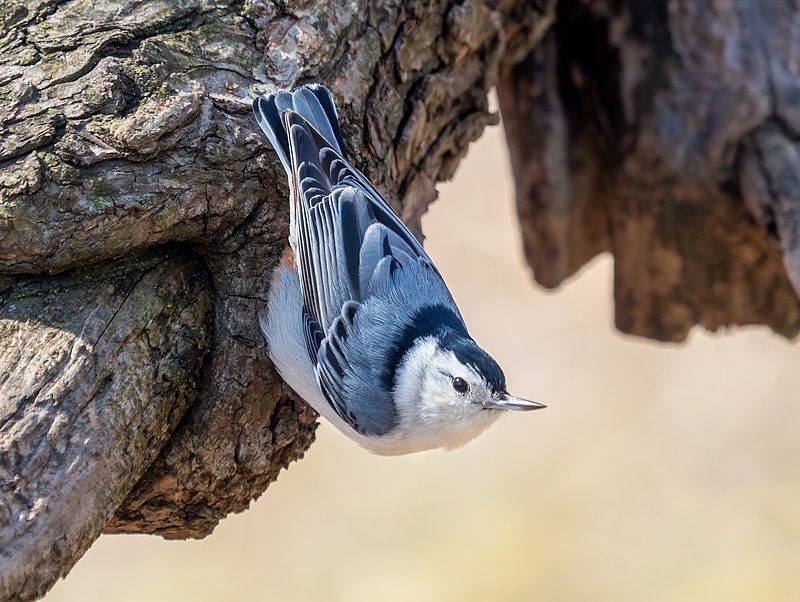
The White-breasted Nuthatch is a medium-sized bird belonging to the nuthatch family Sittidae. It measures around 15.5 cm in length and its color varies throughout its range.
Males have a light blue-grey upperpart, with a black crown and nape whereas females have a dark grey crown instead of a black one.
The underparts are whitish, with a reddish tinge on the sides and flanks while the bill is short and stout with a pale base near the eyes which can be yellow or white depending upon geographic location..
This species feeds mainly on insects but will also eat seeds, nuts, and berries when available.
They prefer open woodlands where they often climb trees searching for food along trunks as well as branches underneath bark crevices creating their nest there too.
Scientific classification:
| Kingdom | Animalia |
| Phylum | Chordata |
| Class | Aves |
| Order | Passeriformes |
| Family | Sittidae |
| Genus | Sitta |
| Species | S. carolinensis |
Also Featured In: Birds in Iowa Spring, Small Kentucky Birds
16. Anna’s Hummingbird
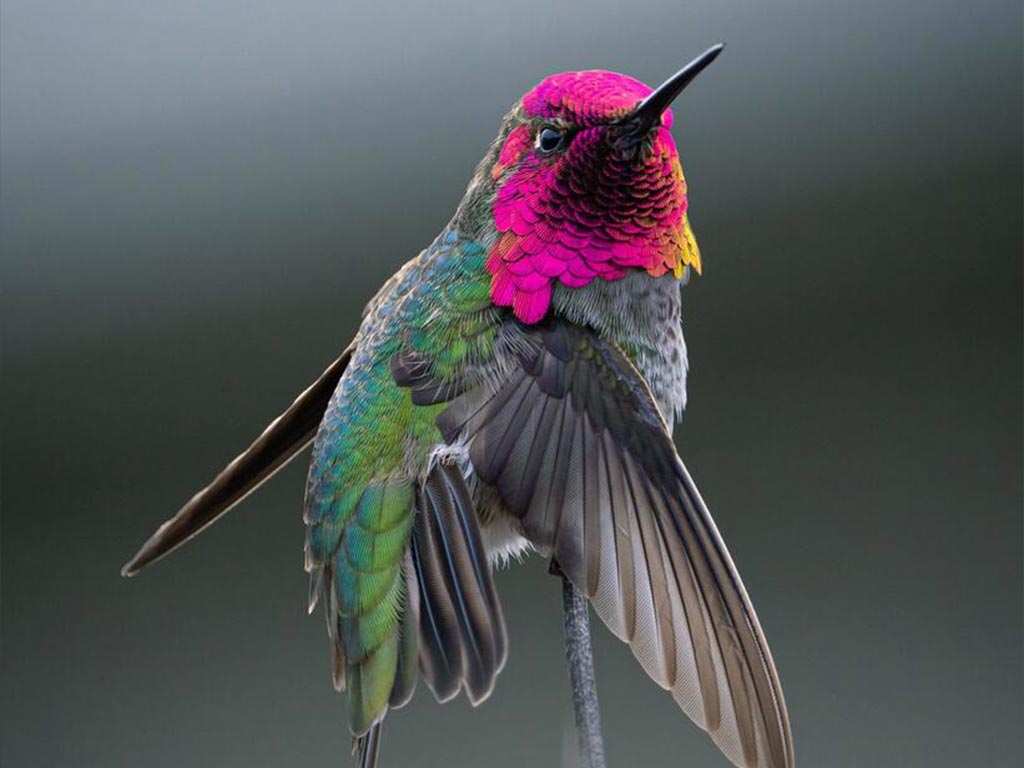
Anna’s hummingbird is a beautiful species of bird belonging to the Trochilidae family. Native to western coastal regions of North America, it was named after Anna Masséna, Duchess of Rivoli.
In the early 20th century, these birds bred only in northern Baja California and southern California but due to ornamental plant transplanting they can now be found across much of the Pacific Coast region.
They are medium-sized with bright emerald green feathers on their back and crowns as well as rose-red patches at the throat for males which makes them quite distinguishable from other birds.
Their diet consists mainly of nectar from flowers although they will occasionally feed on insects or spiders too making them important pollinators that help maintain healthy ecosystems.
Scientific classification:
| Kingdom | Animalia |
| Phylum | Chordata |
| Class | Aves |
| Order | Apodiformes |
| Family | Trochilidae |
| Genus | Calypte |
| Species | C. anna |
Also Featured In: Orange County Birds You Need to See, Red birds You’ll See in Arizona
17. Red-Winged Blackbird

The red-winged blackbird is a beautiful bird found in most of North America and Central America.
Its distinct features include a glossy black body, with white shoulder patches and bright red wing coverts year round.
It prefers wetland habitats such as marshes, ponds, lakeshores, and agricultural fields. During breeding season they inhabit grassy areas near water then move south for the winter months.
For food, they mainly eat insects but also consume wild fruit or grains.
They are very social birds often seen in large flocks during migration times when their unmistakable “conk-la-ree” call can be heard echoing across the sky.
Scientific classification:
| Kingdom | Animalia |
| Phylum | Chordata |
| Class | Aves |
| Order | Passeriformes |
| Family | Icteridae |
| Genus | Agelaius |
| Species | A. phoeniceus |
Also Featured In: Birds that Calls in the Morning, Wetlands Birds You Should Know
18. American Wigeon
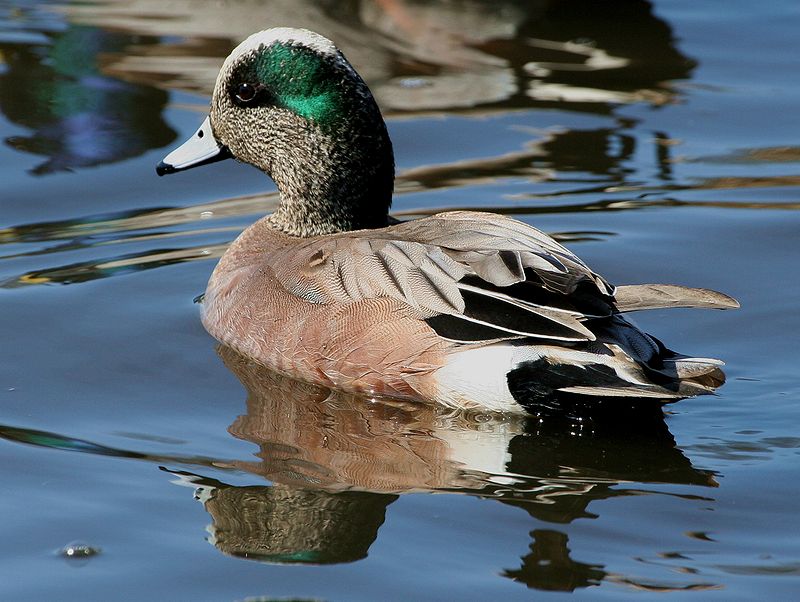
The American Wigeon, also known as the Baldpate, is a species of dabbling duck found throughout North America.
It closely resembles its Eurasian counterpart and was formally described in 1789 by German naturalist Johann Friedrich Gmelin.
This medium-sized bird has an overall grey body with white feathers on its face and belly that give it a distinctive bald appearance.
Its wings are brownish black with green speculum markings on them while the tail is dark brown or black at the base and gradually lightens near tips to become chestnut colored.
The male wigeons have purple patches on their heads during breeding season along with yellow eyes which helps differentiate them from females who have duller colors around their faces instead of bright ones like males possess.
Scientific classification:
| Kingdom | Animalia |
| Phylum | Chordata |
| Class | Aves |
| Order | Anseriformes |
| Family | Anatidae |
| Genus | Mareca |
| Species | M. americana |
Also Featured In: Most Popular Bird Species in North America, Estuaries Birds
19. Brown-Headed Cowbird
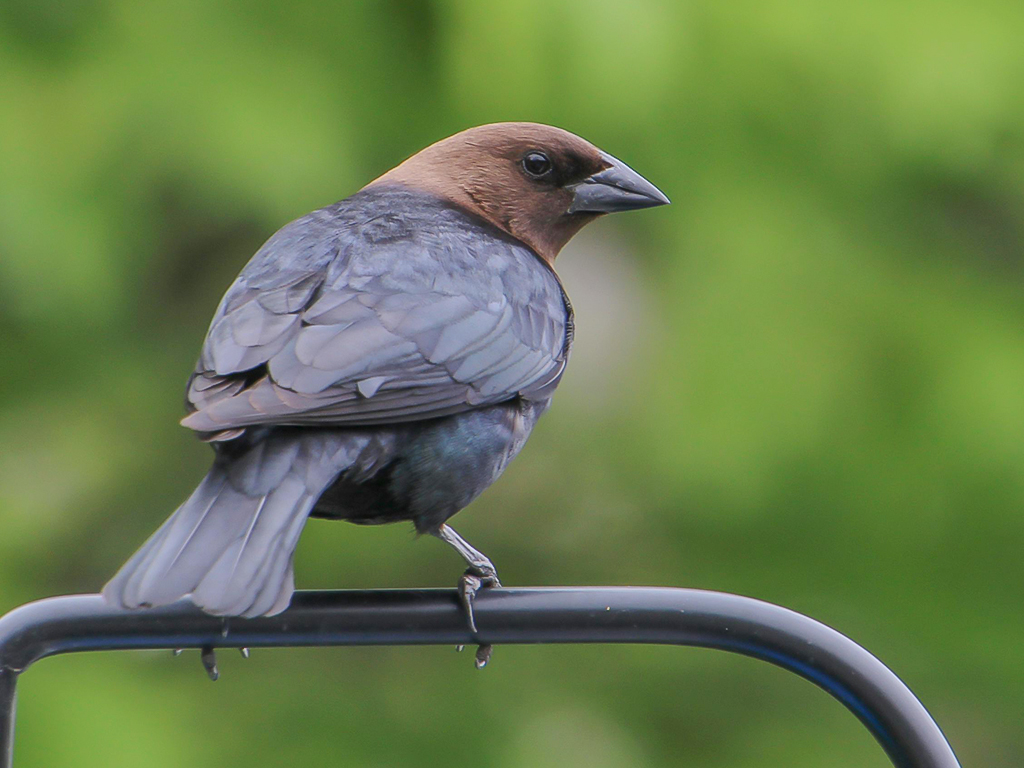
The Brown-headed Cowbird is a small, obligate brood parasitic icterid native to temperate and subtropical North America. It has a brown head with glossy black plumage on the body, wings, and tail feathers.
During summer months it can be found in prairies, grasslands as well as open wooded areas but during winter they migrate southwards towards the United States of Mexico for warmer climates.
They are mainly insectivorous birds that feed on insects like caterpillars or beetles but also consume some grains.
The female bird lays its eggs in nests of other species and then incubates them until hatching time thus leaving their chicks uncared for by themselves.
Scientific classification:
| Kingdom | Animalia |
| Phylum | Chordata |
| Class | Aves |
| Order | Passeriformes |
| Family | Icteridae |
| Genus | Molothrus |
| Species | M. ater |
Also Featured In: Birds You’ll Find in Vancouver Island, Brown Birds that Live in West Virginia
20. Barn Swallow
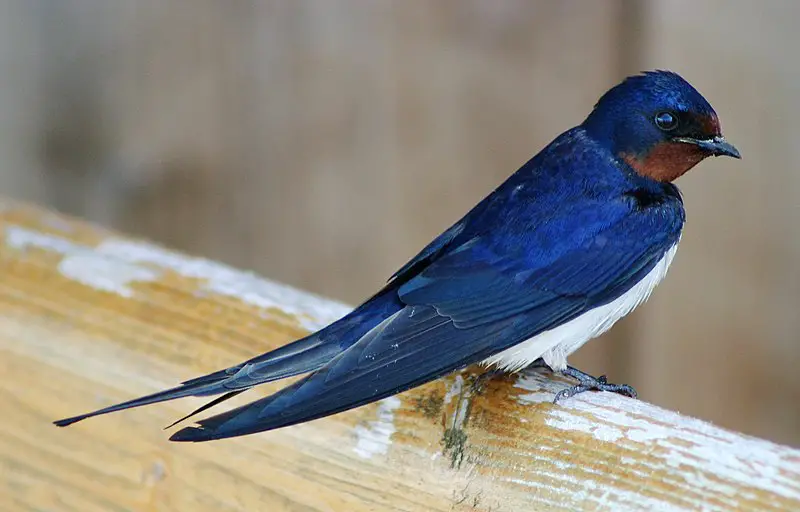
The Barn Swallow is a beautiful passerine bird with blue upperparts and a long, deeply forked tail. Found in Europe, Asia, Africa and the Americas.
It has an astonishingly large natural distribution spanning 251 million square kilometers globally; likely making it one of the world’s most widespread species.
This swallow typically nests near human habitation as well as other open areas such as fields or grasslands which provide them with suitable invertebrate prey to feed on.
They are insectivorous birds that often fly together in flocks looking for food over rivers or marshes usually just above tree-top level.
The barn swallow can also be identified by its strong flight consisting of swift continuous wing beats interspersed with glides during which they hold their wings slightly raised at the shoulders giving them distinct V-shaped silhouettes in the sky.
Scientific classification:
| Kingdom | Animalia |
| Phylum | Chordata |
| Class | Aves |
| Order | Passeriformes |
| Family | Hirundinidae |
| Genus | Hirundo |
| Species | H. rustica |
Also Featured In: Birds that Live in Croatia, Common Estonian Birds
21. American White Pelican
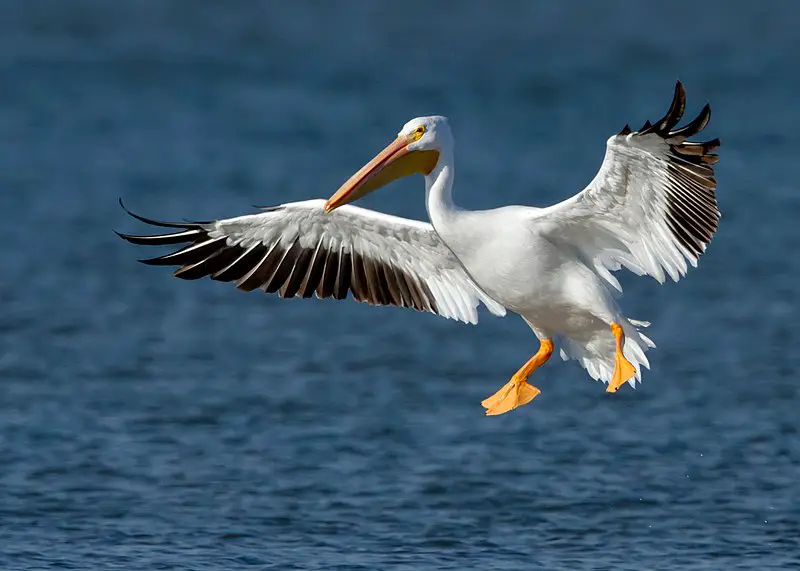
The American White Pelican is a majestic bird from the Pelecaniformes order, known for its impressive size and ability to soar gracefully in the sky.
It breeds during summer months in North America and migrates southwards towards Central and South America during winter.
The species was first described by German naturalist Johann Friedrich Gmelin back in 1789 as part of his updated version of Carl Linnaeus’ work.
This large aquatic bird has an all-white plumage with black primary flight feathers on its wings, while its beak features a characteristic yellowish coloration at the base near the face.
Its diet mainly consists of fish which it typically catches after dipping into water using its long bill; yet sometimes they can be seen stealing food items from other birds such as cormorants or gulls.
Scientific classification:
| Kingdom | Animalia |
| Phylum | Chordata |
| Class | Aves |
| Order | Pelecaniformes |
| Family | Pelecanidae |
| Genus | Pelecanus |
| Species | P. erythrorhynchos |
Also Featured In: Birds You’ll Find in South Texas , Birds that Live around Central Florida
22. Canada Goose
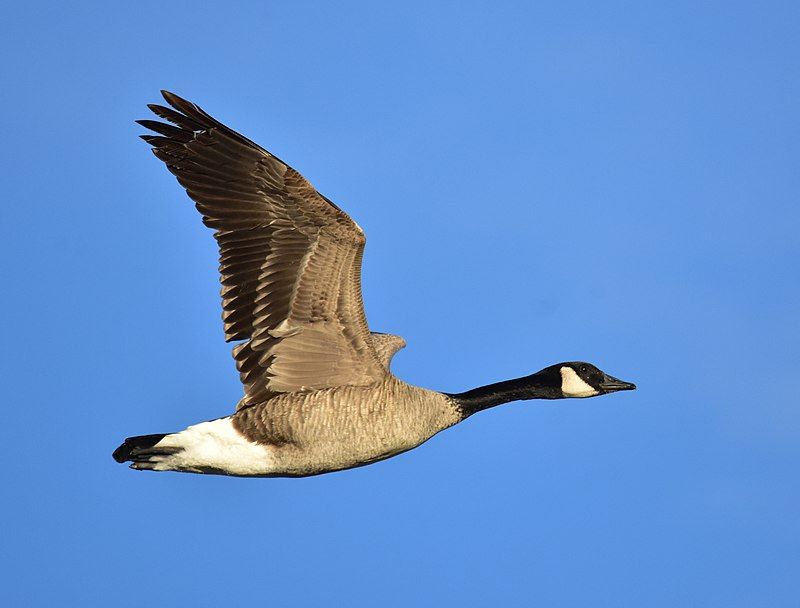
The Canada goose is a majestic bird with a black head and neck, white cheeks, chin, and brown body. It’s native to North America but occasionally migrates to northern Europe across the Atlantic.
The species has been introduced in the United Kingdom, Ireland, and Finland as well. Canada geese are strong flyers that travel in flocks for protection from predators; they also form monogamous pairs for life.
They feed on grasses or grains near ponds or wetlands where they make their nests of down which incubate eggs during summertime before hatching them out into goslings later on.
Scientific classification:
| Kingdom | Animalia |
| Phylum | Chordata |
| Class | Aves |
| Order | Anseriformes |
| Family | Anatidae |
| Genus | Branta |
| Species | B. canadensis |
Also Featured In: Birds that Commonly Found in Pond , Birds in Pacific Northwest
23. Woodpeckers
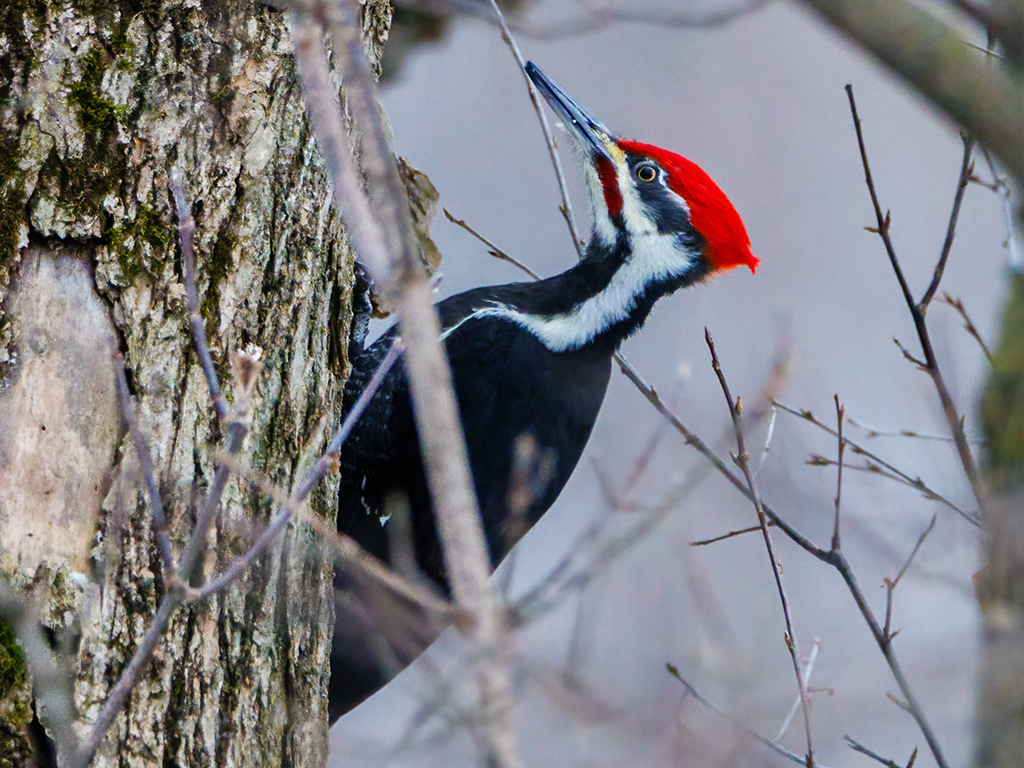
Woodpeckers are an incredibly diverse bird species, found all over the world except for Australia, New Guinea, New Zealand, Madagascar, and the extreme polar regions.
They live in a variety of habitats including forests and woodlands but also rocky hillsides and deserts with no trees.
Their beaks are adapted to pecking at tree bark to find food such as insects or larvae hidden beneath it while they use their long tongues to catch them from deep inside crevices.
Woodpeckers have tough skulls that protect their brains from impact when they bang into things during drumming a behaviour used by males for territorial signalling and reproduction purposes which is done using strong rapid beats against hollow objects like dead branches or metal poles.
Scientific classification:
| Kingdom | Animalia |
| Phylum | Chordata |
| Class | Aves |
| Order | Piciformes |
| Infraorder | Picides |
| Family | Picidae Leach, 1820 |
Also Featured In: Most Common Types of Bangladeshi Birds, Common Serbian Birds
24. Herons
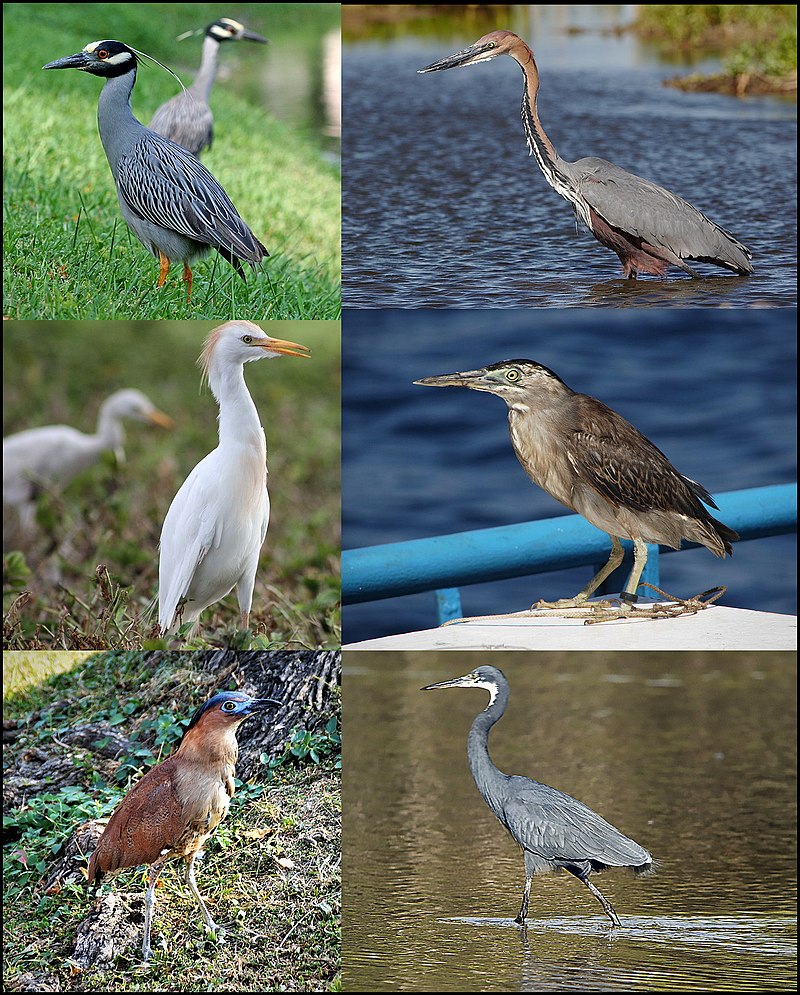
Herons are graceful and elegant birds belonging to the family Ardeidae, with 72 distinct species.
They have long legs and necks that are well-adapted for wading in shallow water like streams or ponds.
Herons can be found near freshwaters as well as along coastal areas worldwide.
Some of these species may also be referred to as egrets, bitterns, or zigzag heron/bitterns because they belong to certain genera such as Botaurus and Ixobrychus respectively.
These birds stand tall when searching for food by standing still in a shallow body of water while waiting patiently until prey appears before quickly capturing it with their sharp bills.
Scientific classification:
| Kingdom | Animalia |
| Phylum | Chordata |
| Class | Aves |
| Order | Pelecaniformes |
| Suborder | Ardei |
| Family | Ardeidae Leach, 1820 |
Also Featured In: Famous Paintings Birds, Birds You’ll Find in Moldova
25. Ducks
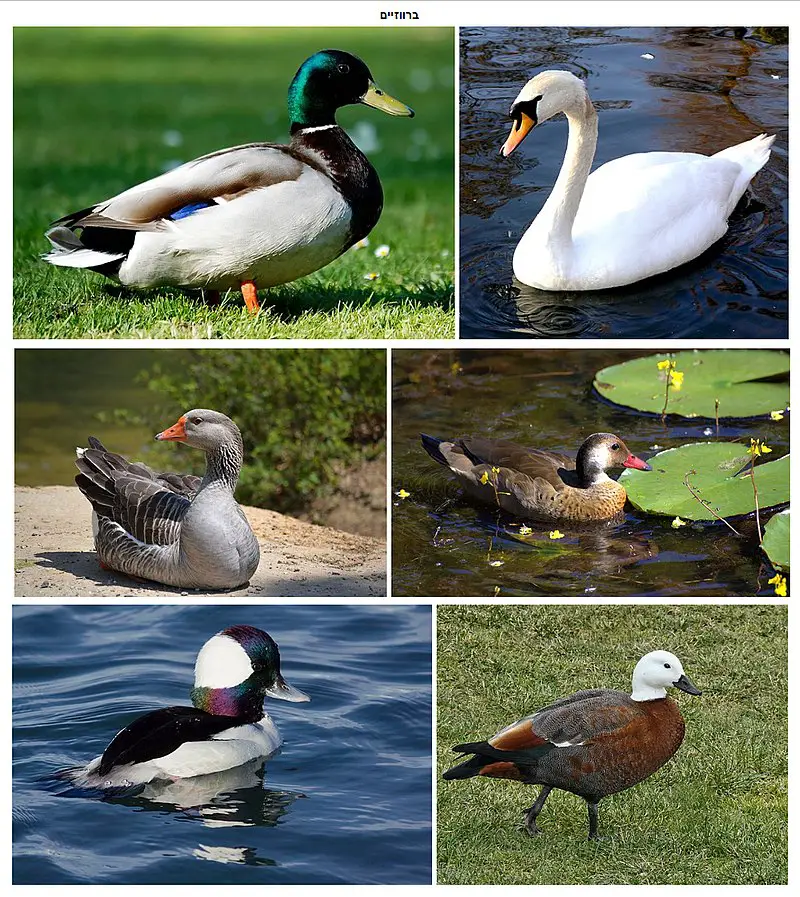
Ducks are water birds belonging to the family of Anatidae. They have a worldwide distribution except for Antarctica and are highly adapted for swimming, floating on the water surface,s or in shallow depths.
Ducks come in various sizes ranging from small teals to large swans with around 174 species found across 43 genera.
Their feathers make them waterproof enabling ducks to stay afloat even in stormy waters while their webbed feet allow them to swim gracefully underwater.
Ducks usually feed by filtering food items such as insects, mollusks, and crustaceans through their bills but some also graze on land vegetation like grasses & grains depending upon the availability of resources at different locations they inhabit.
Scientific classification:
| Kingdom | Animalia |
| Phylum | Chordata |
| Class | Aves |
| Order | Anseriformes |
| Suborder | Anseres |
| Superfamily | Anatoidea |
| Family | Anatidae Leach, 1820 |
Also Featured In: Birds of Sweden, Black And White Birds You Don’t Know About
26. Shrike
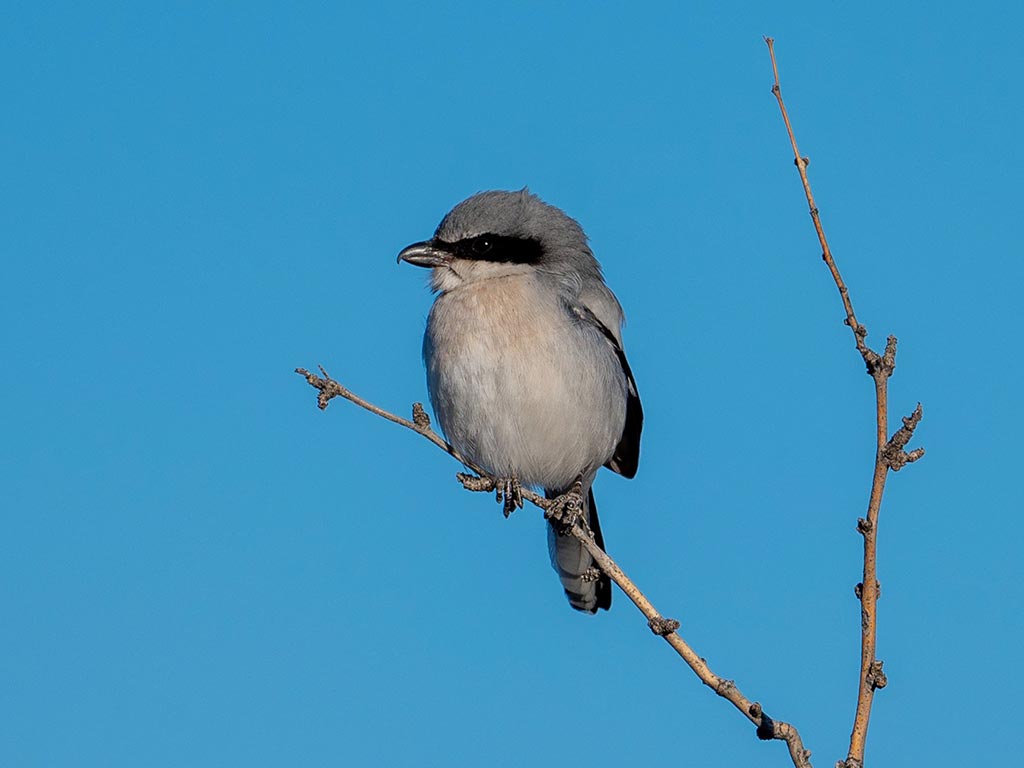
Shrikes are small passerine birds of the family Laniidae, with 34 species in four genera. They get their name from the Old English word “scrīc”, which refers to their shriek-like call.
These birds have earned the nickname ‘butcherbirds’ due to their feeding habits; they impale prey on thorns or barbed wire fences for later consumption.
Shrikes also tend to be aggressive predators and hunt a wide range of animals such as insects, small reptiles, rodents, and even other smaller bird species.
In terms of physical appearance, these songbirds can vary greatly depending on the specific genus but usually boast a large hooked bill atop an impressive crest along with bright colors like gray, black, or brownish hues across their feathers.
Shrike is quite a remarkable creature that has gained notoriety for both hunting prowess and distinctive vocalizations.
Scientific classification:
| Kingdom | Animalia |
| Phylum | Chordata |
| Class | Aves |
| Order | Passeriformes |
| Superfamily | Corvoidea |
| Family | Laniidae Rafinesque, 1815 |
Also Featured In: Egyptian Birds, Common Uzbekistan Birds
27. Eurasian Teal
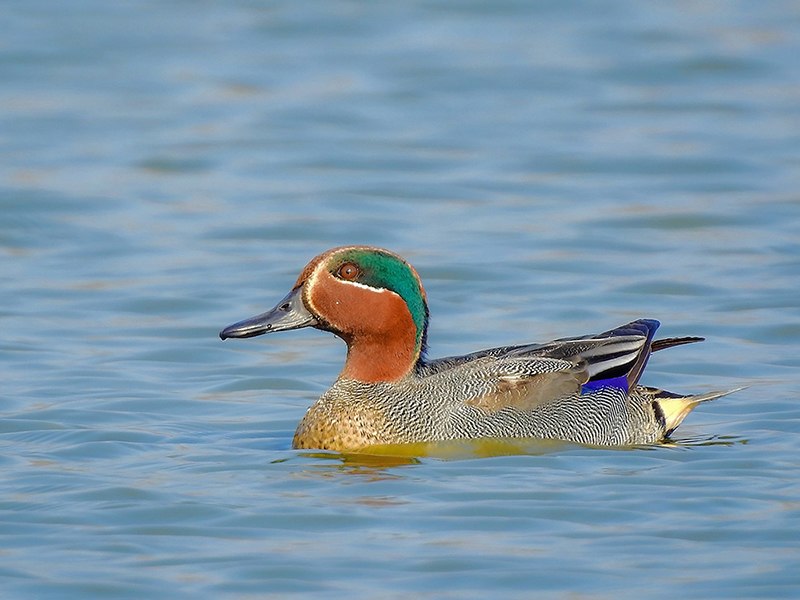
The Eurasian teal, also known as the common teal or the Eurasian green-winged teal, is a small dabbling duck that inhabits temperate Europe and Asia.
It has an unmistakable blue-green coloring which gives it its name.
During winter months they migrate south in large flocks to areas with warmer climates where there is more food available for them to feed on.
The Eurasian Teals are highly social birds; they often congregate in groups of hundreds or even thousands during migration periods.
They mostly feed on aquatic vegetation such as grasses and weeds but will occasionally hunt insects too.
These ducks make beautiful sights when flying over lakes or streams, their wings producing a distinctive whistling sound while they glide across the sky.
Scientific classification:
| Kingdom | Animalia |
| Phylum | Chordata |
| Class | Aves |
| Order | Anseriformes |
| Family | Anatidae |
| Genus | Anas |
| Species | A. crecca |
Also Featured In: Birds of United Kingdom, Tokyo Birds You Need to Know
28. Cormorants
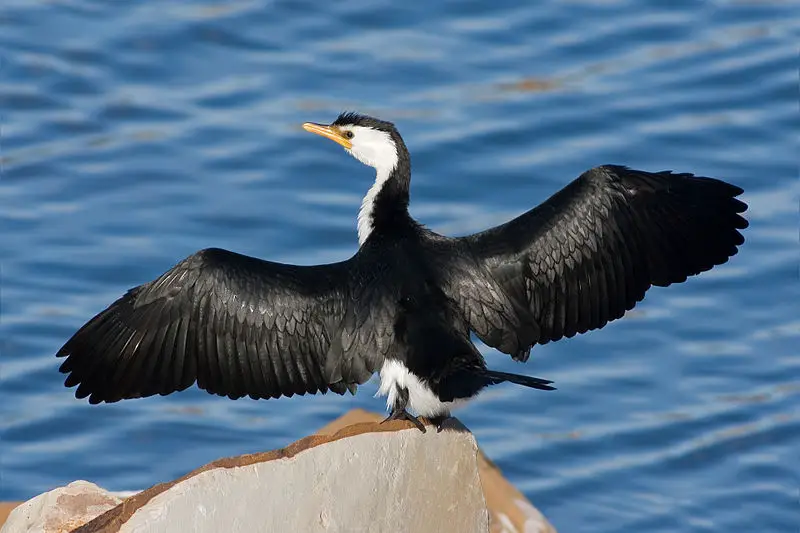
Cormorants are a family of aquatic birds found around the world. They include 40 species, such as great cormorants and common shags.
In Britain, these two species are the most commonly seen in their natural habitats.
Cormorants have long necks, and webbed feet and can be identified by their glossy black feathers which they use to help them swim through water with ease as they hunt for food like fish or crustaceans.
They have an impressive wingspan often reaching up to five feet across when fully extended.
Despite being strong swimmers, these birds also enjoy spending time perched on rocks near rivers or shorelines where they will preen themselves in order to keep clean and dry during cooler weather conditions.
Scientific classification:
| Kingdom | Animalia |
| Phylum | Chordata |
| Class | Aves |
| Order | Suliformes |
| Family | Phalacrocoracidae Reichenbach, 1850 |
Also Featured In: Most common Birds in France, Birds That Live in Iraq
29. Procellariidae
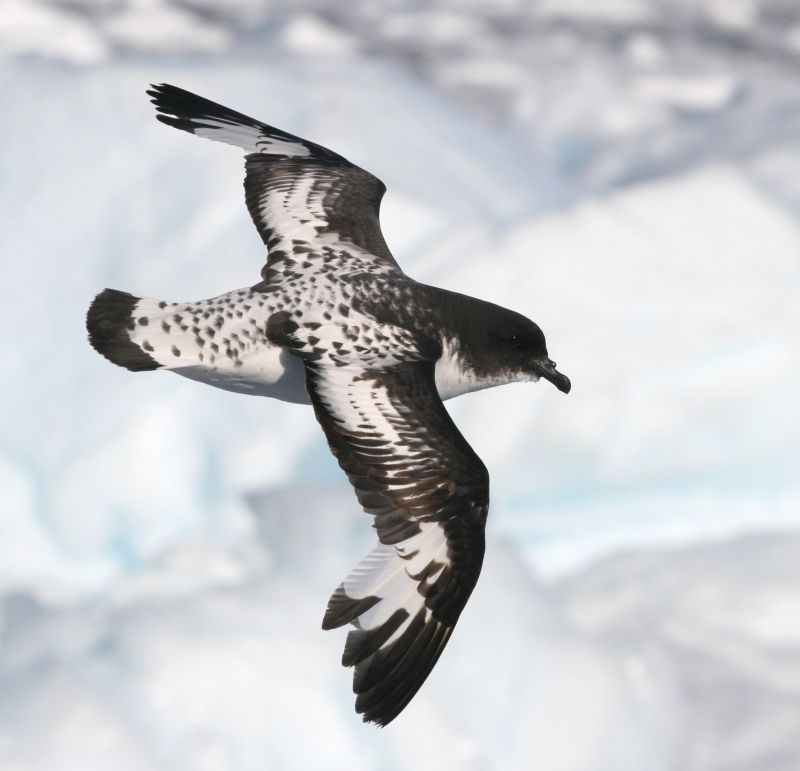
Procellariidae is a diverse family of seabirds belonging to the bird order Procellariiformes.
These birds are commonly referred to as tubenoses and include fulmarine petrels, gadfly petrels, diving petrels, prions, and shearwaters.
They range in size from the small storm petrel which measures around 18cm long to the giant albatross which can reach up to 3 meters in length.
Generally found near oceans or coasts where they feed on fish as well as squid and other marine life depending on species.
Many procellariids will also nest inland during the breeding season before returning out to sea for most of their lives.
Their wings have specially adapted feathers that give them incredible gliding abilities allowing them fly with minimal effort over vast distances across oceanic regions
Scientific classification:
| Kingdom | Animalia |
| Phylum | Chordata |
| Class | Aves |
| Order | Procellariiformes |
| Family | Procellariidae Leach, 1820 |
Also Featured In: Bulgarian Birds, Lebanon Birds Live in Semi-Desert Areas
30. Tyrant Flycatchers
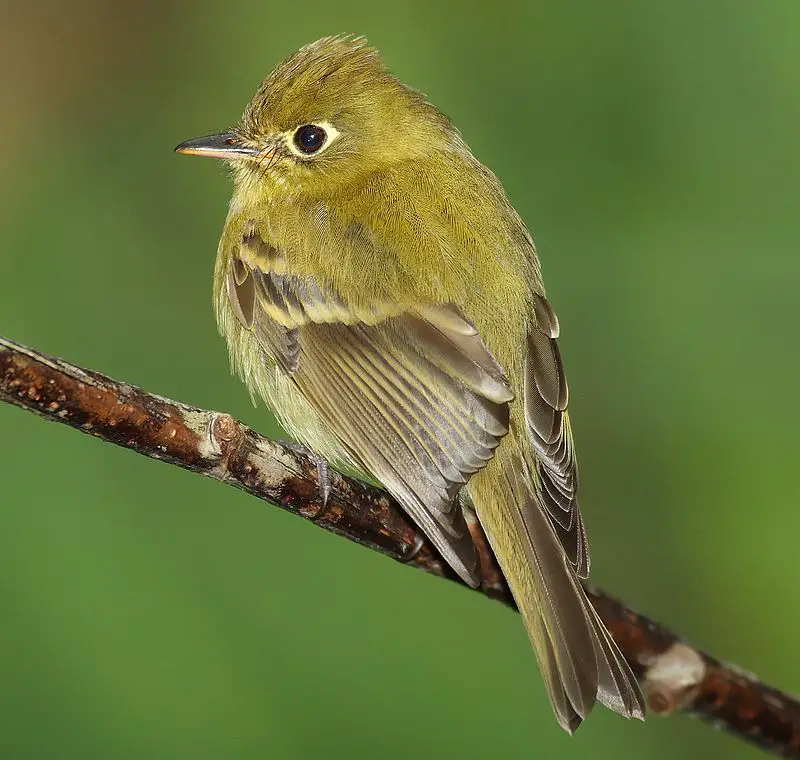
Tyrant flycatchers are a family of birds found in North and South America, containing over 400 species. These birds come in an array of shapes and sizes, with vibrant plumage to match.
They are the most diverse avian family across all countries they inhabit except for the United States and Canada.
Their diet consists mainly of insects but also includes small reptiles or amphibians where available.
The behavior varies between each bird; some prefer open areas while others like dense forests as their habitat many even migrate regularly.
Tyrant Flycatchers have adapted well to human presence thanks to the abundance of food sources that often accompany them such as backyards, parks, etc.
All things considered, these incredible creatures are truly amazing.
Scientific classification:
| Kingdom | Animalia |
| Phylum | Chordata |
| Class | Aves |
| Order | Passeriformes |
| Parvorder | Tyrannida |
| Family | Tyrannidae Vigors, 1825 |
Also Featured In: Birds of Argentina, Birds that You’ll Find in Puerto Rico
31. Icterids
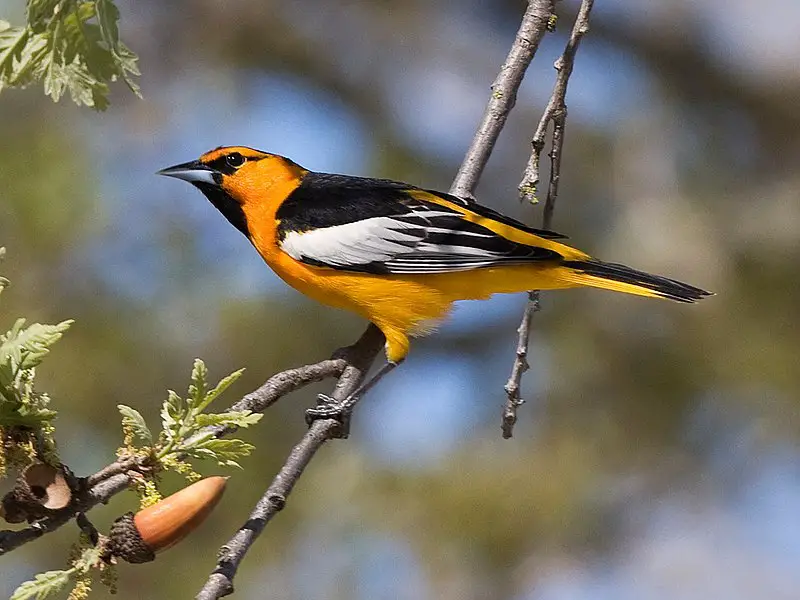
Icterids are a family of small to medium-sized, often colorful New World passerine birds. They have black as their predominant plumage color with yellow, orange, or red adding vibrancy and life.
Their sizes range greatly in shape and behavior making them unique amongst other bird species.
The name Icterid comes from the Latin word ‘ictericus’ which means jaundiced ones – referring to the prominent yellow coloring found on some of these birds’ feathers.
These beautiful creatures can be seen flying around many different parts of South America where they live with their young for most of the year before migrating northwards during the fall season.
Scientific classification:
| Kingdom | Animalia |
| Phylum | Chordata |
| Class | Aves |
| Order | Passeriformes |
| Superfamily | Emberizoidea |
| Family | Icteridae Vigors, 1825 |
Also Featured In: Common Birds in Canada, British Virgin Islands Birds You Need to See
32. Great Blue Heron

The Great Blue Heron is a majestic wading bird found in many parts of North America, Central America, the Caribbean, and even as far away as the Galapagos Islands.
It has an impressive wingspan which can reach up to six feet wide. Its feathers are mainly bluish-gray with brownish streaks on both its neck and chest while its head displays white plumes.
The adult herons can also be identified by their yellow bill and legs.
They live near bodies of water such as lakes, marshes, or rivers where they feed on fish using a spear-like motion with their sharp bills.
An all-white population exists only in South Florida and the Florida Keys making it unique.
Scientific classification:
| Kingdom | Animalia |
| Phylum | Chordata |
| Class | Aves |
| Order | Pelecaniformes |
| Family | Ardeidae |
| Genus | Ardea |
| Species | A. herodias |
Also Featured In: Birds that Live in the Deserts, Galapagos Birds You Should Know
33. Song Sparrow

The Song Sparrow (Melospiza melodia) is a small, yet abundant bird found in North America.
They have brown upperparts with dark streaks and are white underneath, complete with a distinct dark brown spot on the breast.
Their cap is also brown and long roughed feathers can be seen sprouting from their neck area.
This sparrow species is highly variable and adaptable to many different environments including dry brush land, wetlands, or open fields.
It has been noted that adult song sparrows will sing even during winter months when other birds remain quiet.
These energetic little animals make for great backyard companions as they flit about singing their lovely melodies.
Scientific classification:
| Kingdom | Animalia |
| Phylum | Chordata |
| Class | Aves |
| Order | Passeriformes |
| Family | Passerellidae |
| Genus | Melospiza |
| Species | M. melodia |
Also Featured In: Birds that Live in Vancouver, Birds of Nova Scotia
34. Pileated Woodpecker
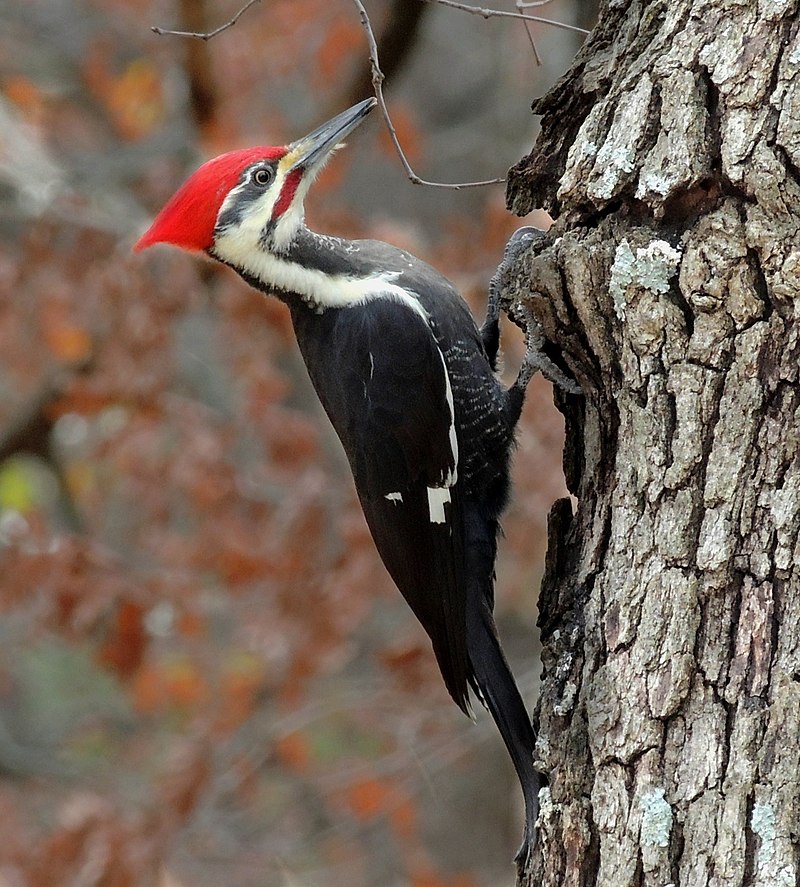
The pileated woodpecker is a large, majestic bird native to North America.
Its striking black plumage and red crest make it an unmistakable sight in the forest canopy of deciduous forests across eastern North America, the Great Lakes region, Canada’s boreal forests, and parts of the Pacific Coast.
It is one of the largest woodpeckers in North America: larger than any other confirmed species except for perhaps its relative; the ivory-billed woodpecker.
Insectivorous by nature, this stunning creature can be seen pecking away at tree trunks searching for food, or making nest cavities – all with remarkable skill.
The pileated woodpecker truly stands out as a symbol of beauty and resilience amongst our avian wildlife.
Scientific classification:
| Kingdom | Animalia |
| Phylum | Chordata |
| Class | Aves |
| Order | Piciformes |
| Family | Picidae |
| Genus | Dryocopus |
| Species | D. pileatus |
Also Featured In: Red Birds You’ll See in Oklahoma, Red Birds You’ll Commonly Found in Texas
35. Vireonidae
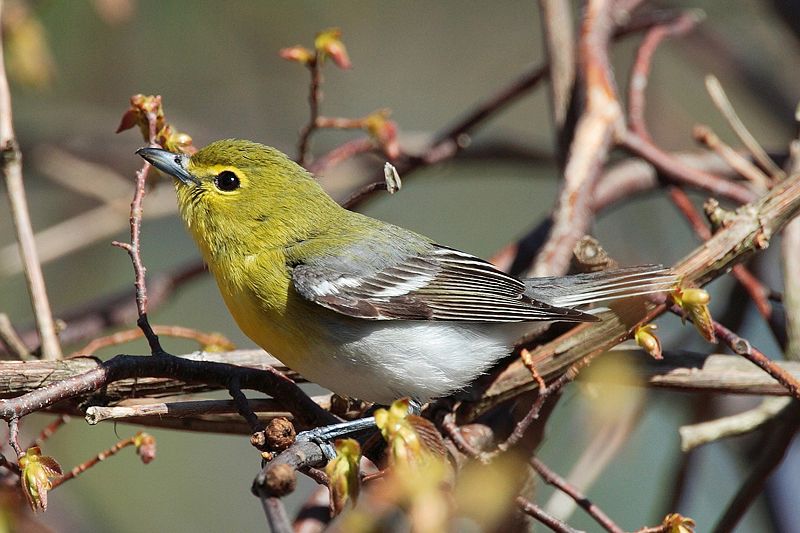
Vireonidae birds are a family of passerine birds found in the New World, Southeast Asia, and other tropical regions.
They have dull plumage with greenish coloration and typically measure between small to medium sizes.
These migratory birds were so named in Latin referring to the female golden oriole or even the European greenfinch.
Vireo species can be seen perching on branches while they feed mainly on insects such as caterpillars, beetles, grasshoppers, and cicadas among others; some also eat fruits which provide them with essential nutrients for their diet.
As well as being known for their musical chirpings during mating season these colorful little creatures make wonderful additions to any garden.
Scientific classification:
| Kingdom | Animalia |
| Phylum | Chordata |
| Class | Aves |
| Order | Passeriformes |
| Superfamily | Orioloidea |
| Family | Vireonidae Swainson, 1837 |
Also Featured In: Birds of Morocco, Asian Birds
36. Red-Tailed Hawk
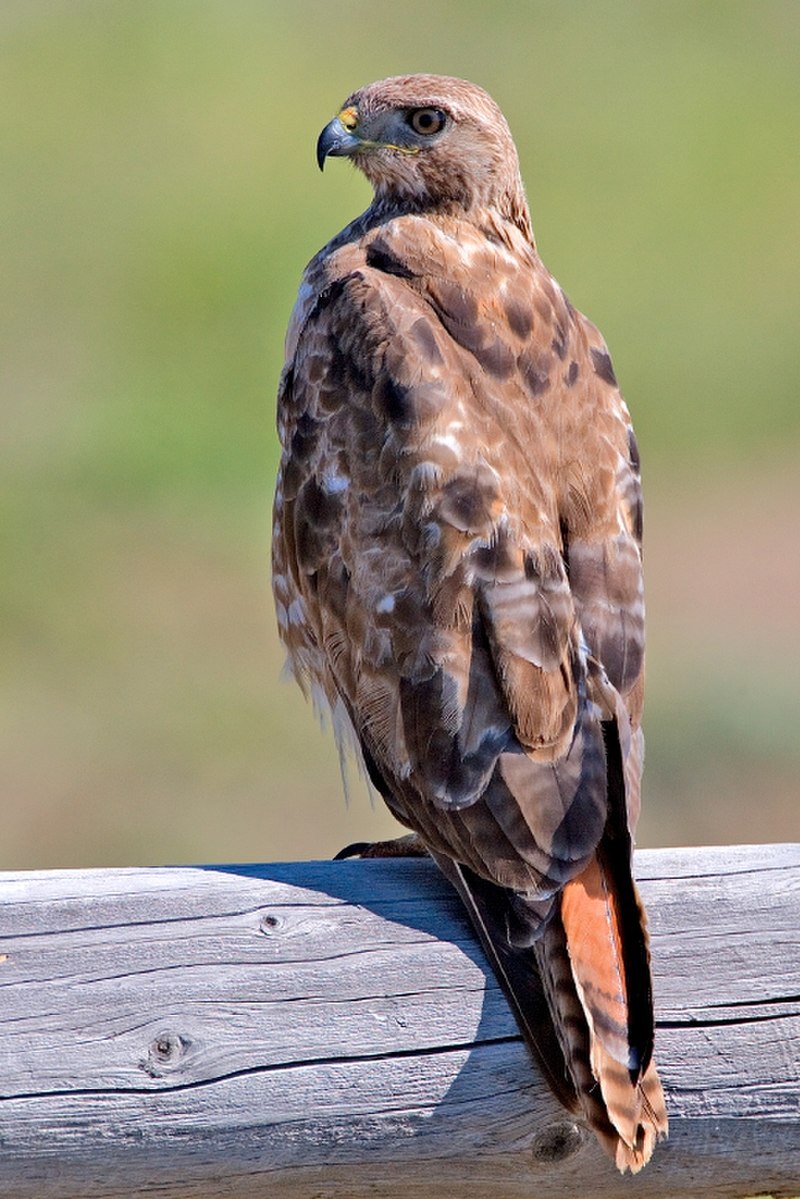
The Red-tailed Hawk is a majestic bird of prey with a distinctive red tail. It can be found throughout North America, from Alaska in the north to Panama and the West Indies in the south.
This species belongs to the Buteo genus, which makes it one of the most common raptors on Earth.
These hawks mainly hunt small mammals such as rabbits or squirrels but also feed on reptiles and birds during migration season.
Unlike other predator birds, they prefer open areas for hunting like fields or grasslands rather than dense forests.
They build their nests high up on trees where they stay all year long unless disturbed by humans or animals nearby.
Their presence has become an iconic part of American culture due to their frequent sightings around homes and parks alike making them beloved creatures among people everywhere.
Scientific classification:
| Kingdom | Animalia |
| Phylum | Chordata |
| Class | Aves |
| Order | Accipitriformes |
| Family | Accipitridae |
| Genus | Buteo |
| Species | B. jamaicensis |
Also Featured In: Dominican Republic birds, Birds You’ll Find in Zoo
37. Tropical Kingbird
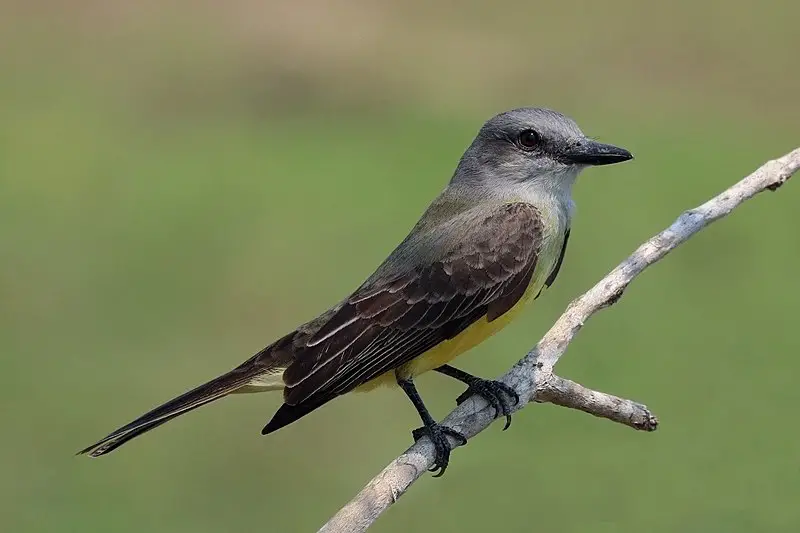
The Tropical Kingbird is an impressive bird, native to the Americas. It’s a large tyrant flycatcher that breeds in southern Arizona and Texas through Central America and down south as far as Argentina and Peru.
This species also lives on Trinidad & Tobago islands. During cold winter months, most of them migrate to warmer climates within its range.
They inhabit open areas such as fields or forests with scattered trees – but away from heavily wooded habitats.
In terms of diet, they mainly feed upon insects that are caught by hawking from perches or snatching up in flight; however, they will occasionally eat fruits too.
The adult has grey-brown upperparts, darker wings edged with yellowish feathers plus a white breast band contrasting against pale orange underparts for both sexes.
A conspicuous black mask runs across their eyes completing this beautiful bird’s look.
Scientific classification:
| Kingdom | Animalia |
| Phylum | Chordata |
| Class | Aves |
| Order | Passeriformes |
| Family | Tyrannidae |
| Genus | Tyrannus |
| Species | T. melancholicus |
Also Featured In: Most Common Birds In Paraguay, Rainforest Birds You Should Know
38. Cooper’s Hawk
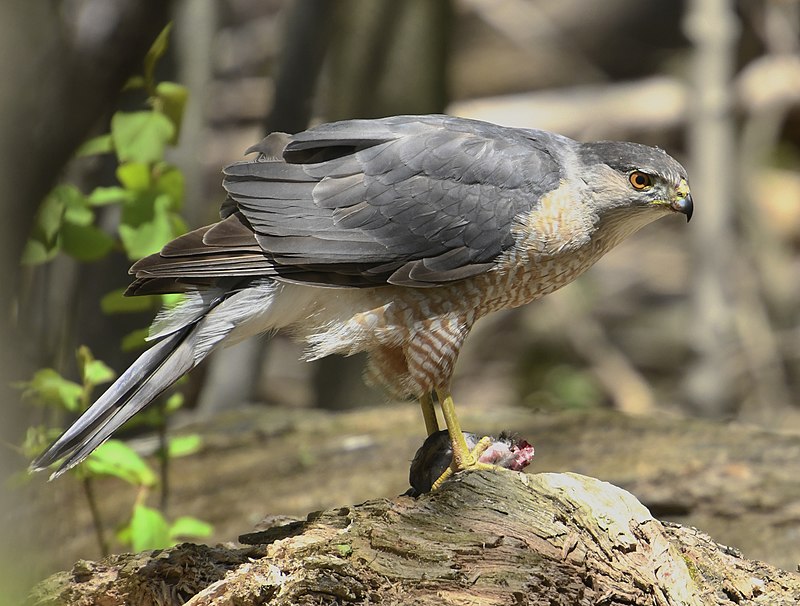
Cooper’s Hawk is a medium-sized bird of prey native to North America. It belongs to the Accipiter genus, which is known for its agility and small size compared to other hawks.
They usually inhabit wooded areas, making them well-adapted hunters in dense environments.
Cooper’s Hawks have rounded wings with short tails that help them maneuver quickly through trees when chasing after prey such as small rodents or birds.
These raptors also possess powerful feet equipped with sharp talons used for catching food items on the ground and even out of midair.
The adult plumage has barred upperparts, ranging from greyish brown on lighter individuals up to dark chestnut colors found in darker specimens; they also display rusty underparts marked by thin white streaking down either side of their chests and bellies.
Scientific classification:
| Kingdom | Animalia |
| Phylum | Chordata |
| Class | Aves |
| Order | Accipitriformes |
| Family | Accipitridae |
| Genus | Accipiter |
| Species | A. cooperii |
Also Featured In: Georgia Birds, Common Birds of Houston
39. Curlew Sandpiper
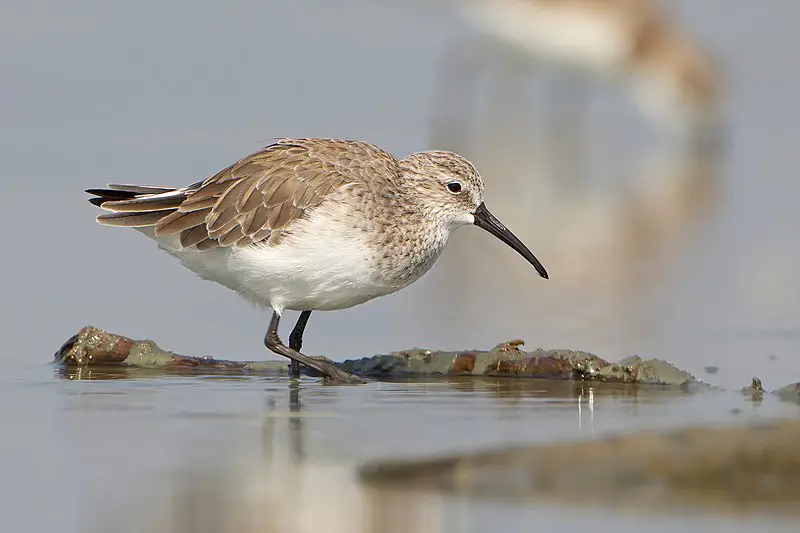
The Curlew Sandpiper is a small wader that breeds in the Arctic tundra of Siberia. It’s strongly migratory, wintering mainly in Africa but also found as far away as Australia and New Zealand.
This bird has been spotted occasionally on North American shores too. The species was first described by Erik Pontoppidan from Denmark back in 1763 under the scientific name Tringa ferrugineus.
Its plumage is predominantly grey-brown with white underneath which gives it its unique look among other sandpipers.
As one of the most long-distance migrants known to science, this amazing creature will travel thousands of miles every year just for food and shelter.
Scientific classification:
| Kingdom | Animalia |
| Phylum | Chordata |
| Class | Aves |
| Order | Charadriiformes |
| Family | Scolopacidae |
| Genus | Calidris |
| Species | C. ferruginea |
Also Featured In: Bahrain birds, Birds that Migrate to Sri Lankan
40. Broad-Winged Hawk
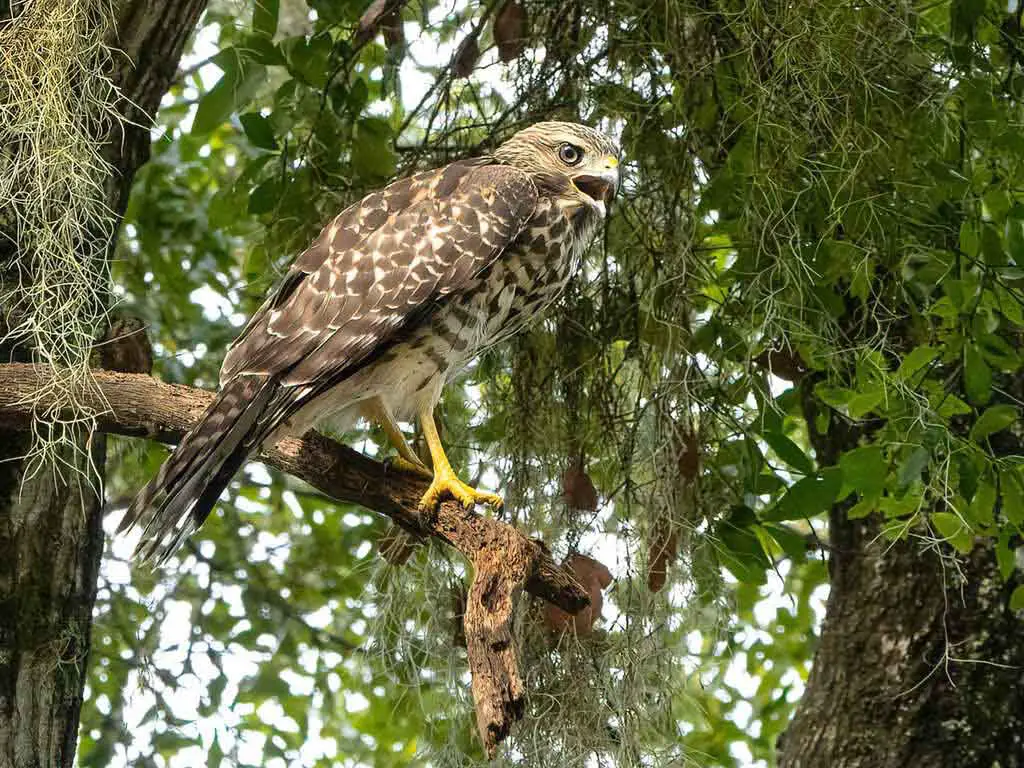
The Broad-winged Hawk is a medium-sized raptor of the Buteo genus. It has distinct subspecies which are distributed throughout eastern North America, ranging from British Columbia to Texas and migrating south during winter months to places like Mexico and Brazil.
Other subspecies are year-round residents in the Caribbean Islands. Like most birds of prey, female Broad-winged Hawks tend to be larger than males – they can have wingspans up to 48 inches.
These hawks feed mainly on small mammals such as mice or voles but also eat insects, reptiles, and amphibians.
They nest high in trees typically near open fields where food sources abound; their nests are often made with sticks lined with grasses or other materials for insulation purposes.
Scientific classification:
| Kingdom | Animalia |
| Phylum | Chordata |
| Class | Aves |
| Order | Accipitriformes |
| Family | Accipitridae |
| Genus | Buteo |
| Species | B. platypterus |
Also Featured In: Saint Lucia Birds,
41. Ash-Throated Flycatcher
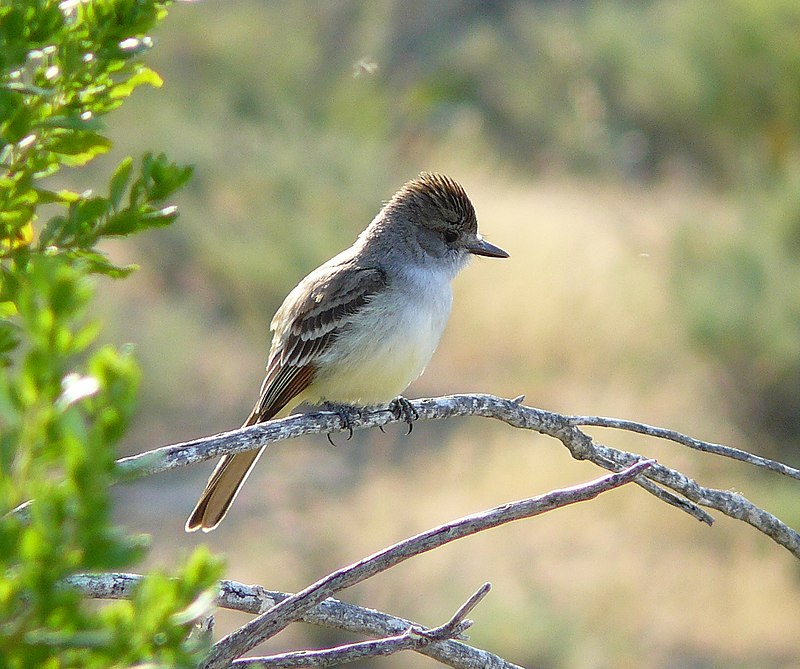
The Ash-throated Flycatcher is a small passerine bird that belongs to the tyrant flycatcher family.
First discovered in 1851 by George Newbold Lawrence, it was initially given the scientific name Tyrannula cinerascens and mistakenly described again as Tyrannula mexicanus.
This species of flycatcher is found primarily in western Texas but can be seen all over America including California, Arizona, and Utah.
They have an ash-gray head with yellowish underparts which gives them their unique coloration.
The back part of their heads are darker brown while they possess two white wingbars on either side of their wings.
They feed mainly on insects such as ants and beetles which they hunt from low perches or even take directly from foliage.
Their call consists of a loud “chek” sound followed by several high-pitched notes at once making for quite a captivating singing performance.
Scientific classification:
| Kingdom | Animalia |
| Phylum | Chordata |
| Class | Aves |
| Order | Passeriformes |
| Family | Tyrannidae |
| Genus | Myiarchus |
| Species | M. cinerascens |
Also Featured In: Flycatchers Species, Most Common Birds in Michoacán
42. Rufous Hummingbird
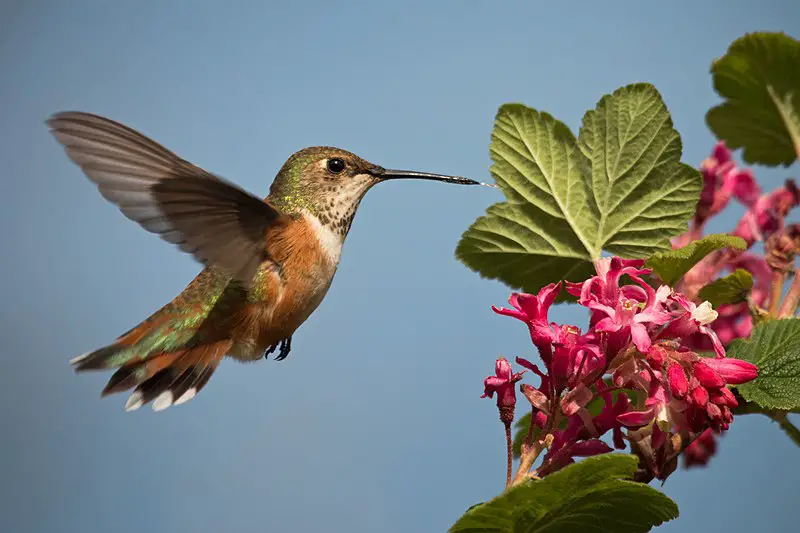
The beautiful Rufous Hummingbird is a small bird of 8 cm in length, with a long slender beak. It stands out due to its extraordinary flight skills and incredible migratory transits- it can fly up to 2,000 miles.
This species was formally described by German naturalist Johann Friedric in 1788 and belongs to the genus Selasphorus.
These birds are found all over North America and parts of Mexico during summertime; while wintering in Central America or northern South America.
They feed on nectar from flowers as well as insects for protein intake. With their vibrant feathers, agile flying abilities, and fascinating life cycle they make an interesting addition to any backyard wildlife habitat.
Scientific classification:
| Kingdom | Animalia |
| Phylum | Chordata |
| Class | Aves |
| Order | Apodiformes |
| Family | Trochilidae |
| Genus | Selasphorus |
| Species | S. rufus |
Also Featured In: Hummingbirds Species, Birds That Live in Colorado
43. Red-Breasted Sapsucker
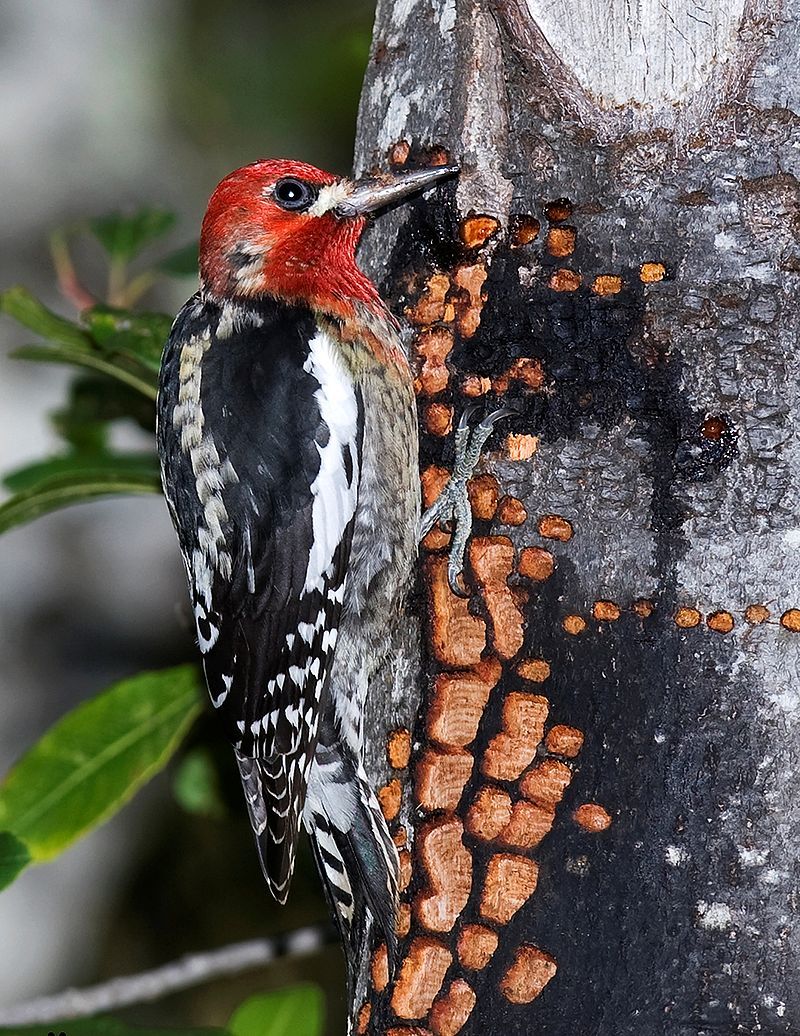
The red-breasted sapsucker is a medium-sized woodpecker native to the forests of the West Coast of North America.
It has a striking appearance with its bright red head and upper chest, white lower belly, black back, and wings with bars and a large white wing patch.
These birds nest in tree cavities during mating season while northern specimens migrate south for winter months.
They are often seen tapping on trees to drill holes into them to feed on sap or bark insects that live beneath them.
Additionally, they have been observed feeding from birdfeeders which makes them great additions to backyard bird-watching activities.
Overall, the red-breasted sapsucker is an interesting species worth discovering.
Scientific classification:
| Kingdom | Animalia |
| Phylum | Chordata |
| Class | Aves |
| Order | Piciformes |
| Family | Picidae |
| Genus | Sphyrapicus |
| Species | S. ruber |
Also Featured In: Woodpeckers Species, Birds that Live in the Grand Canyon National Park
44. Rock Ptarmigan
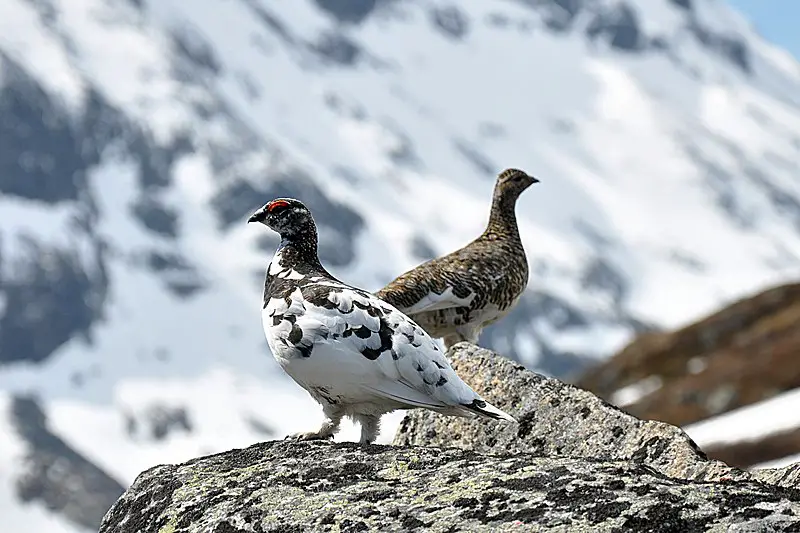
The Rock Ptarmigan is a medium-sized game bird in the grouse family, known simply as the ptarmigan in the UK.
It has been chosen as an official bird for two Canadian territories and provinces; Nunavut (aqiggiq) and Newfoundland & Labrador.
In Japan, it is referred to as raichō which means “thunderbird”. With its white plumage that changes to grey during winter months, it is easily camouflaged against snowdrifts or rocky terrain where they make their nests.
They mainly feed on plants like willow buds and roots but also take insects when available.
The females of this species are brownish with black markings while males have red combs above their eyes making them easy to identify.
Scientific classification:
| Kingdom | Animalia |
| Phylum | Chordata |
| Class | Aves |
| Order | Galliformes |
| Family | Phasianidae |
| Genus | Lagopus |
| Species | L. muta |
Also Featured In: Alaska Birds, Willows Birds Around You
45. Steller’s Jay
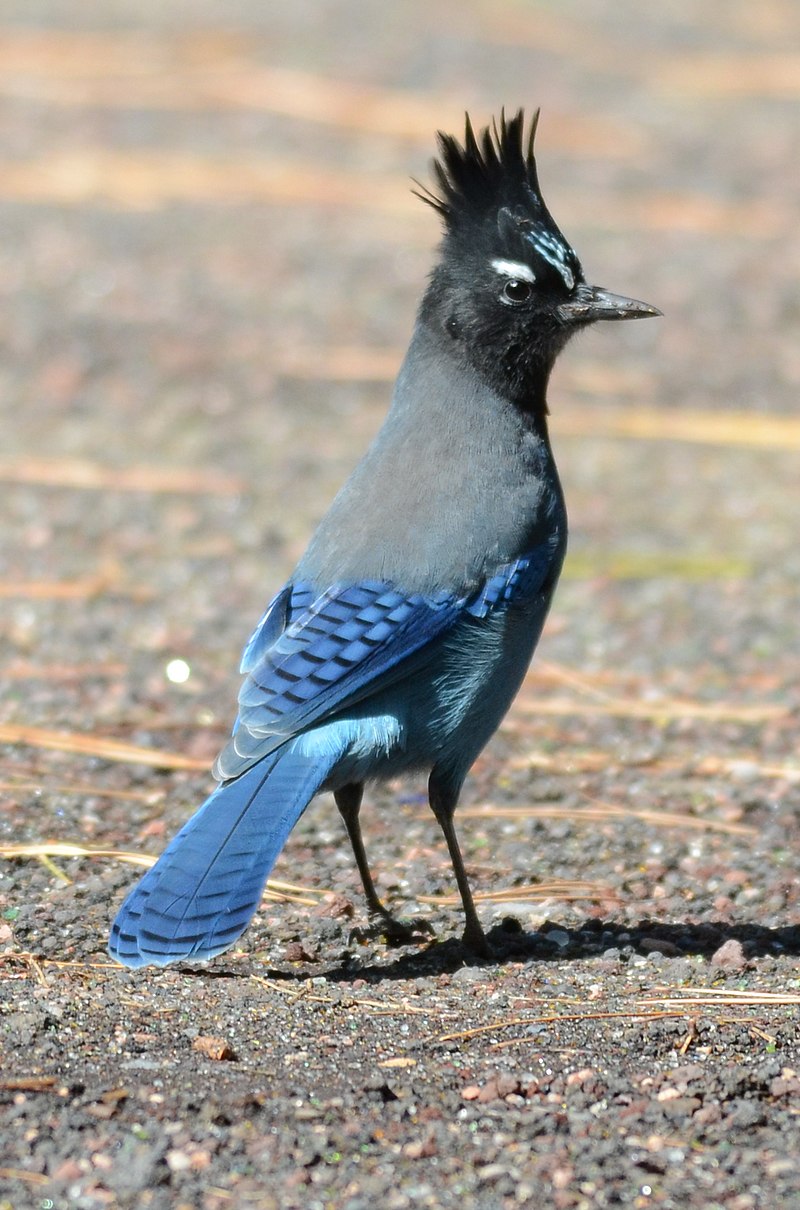
Steller’s jay is a beautiful and colorful bird native to western North America and the mountains of Central America.
It has a distinctive long crest that sets it apart from other birds, with its blue feathers streaked with black, white, gray, and brown markings.
This species is closely related to the blue jays found in eastern North America but can be distinguished by their longer crests.
They are known for being highly vocal birds who like to make loud calls throughout forests they inhabit as well as stealing food from unsuspecting mammals or raiding bird feeders when given the chance.
Steller’s Jays have adapted well to human presence in areas they populate making them great backyard visitors if you’re lucky enough.
Scientific classification:
| Kingdom | Animalia |
| Phylum | Chordata |
| Class | Aves |
| Order | Passeriformes |
| Family | Corvidae |
| Genus | Cyanocitta |
| Species | C. stelleri |
Also Featured In: Blue Birds You’ll Found around Us, Birds That Live around Seattle
46. White-Tailed Ptarmigan
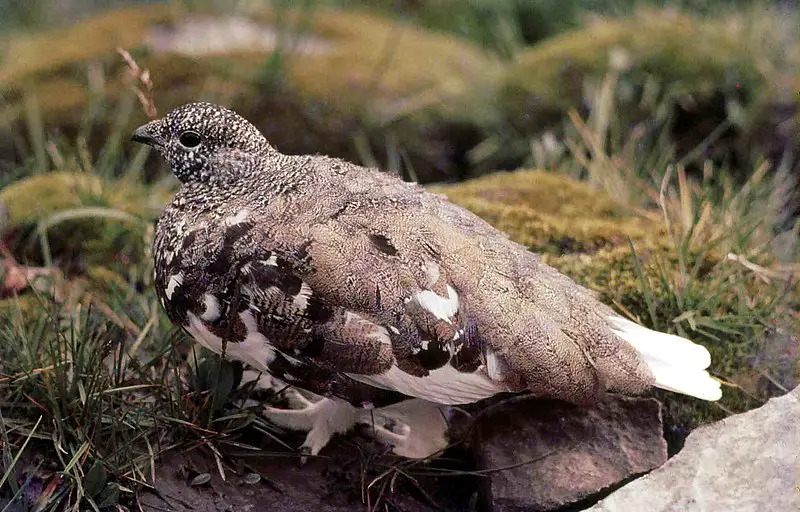
The white-tailed ptarmigan is a small, hardy bird found in high altitudes in Alaska, Canada, and the western US. It belongs to the grouse family and has cryptic plumage that changes with each season.
In summer it sports grey, brown, and white speckles while during winter its feathers become entirely white for camouflage against snow.
This adaption allows it to survive even at temperatures below freezing point.
Its diet consists mostly of plants such as willow buds or twigs but also includes insects like ants which provide additional nutrients when food sources are scarce during winter months.
An interesting behavior trait is their tendency to walk away from predators instead of flying – they can fly but prefer not to.
Scientific classification:
| Kingdom | Animalia |
| Phylum | Chordata |
| Class | Aves |
| Order | Galliformes |
| Family | Phasianidae |
| Genus | Lagopus |
| Species | L. leucura |
Also Featured In: birds of Montana, Tundra Birds
47. Sandpiper
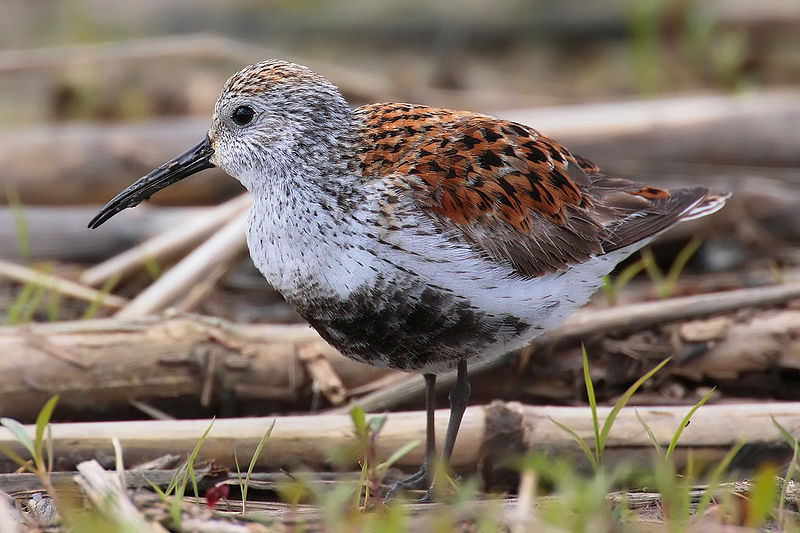
Sandpiper is a type of wading bird that belongs to the family Scolopacidae. It is a diverse family that includes various species such as curlew and snipe.
Sandpipers have different bill lengths that allow them to feed on small invertebrates and creatures found in mud or soil.
Due to this diversity, different species can coexist in the same habitat without competing for food.
Sandpipers are commonly found near the coast but are also found in other wetland environments.
They are known for their slender legs, long beak, and streamlined body that enables them to move easily in and out of water.
Sandpipers are a unique and fascinating bird species that are interesting to observe in their natural habitat.
Scientific classification:
| Kingdom | Animalia |
| Phylum | Chordata |
| Class | Aves |
| Order | Charadriiformes |
| Suborder | Scolopaci |
| Family | Scolopacidae Rafinesque, 1815 |
Also Featured In: Birds You’ll Find in the Sea, Turkey Birds You Should Know
48. Northern Pintail
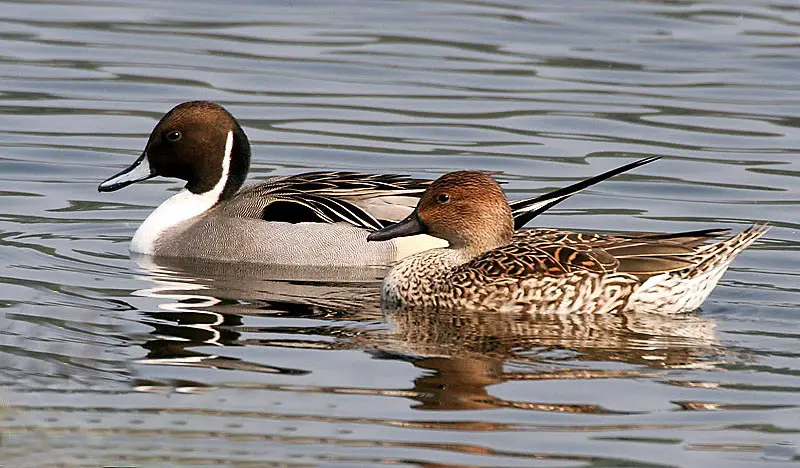
The Northern Pintail is a widespread duck species that breeds in northern parts of Europe, across the Palearctic and North America. This migratory bird winters south of its breeding range to the equator.
Unlike most birds with such a wide range, it does not have any subspecies. The male Northern Pintail has a distinctive long, thin tail and a chocolate-brown head. The female has a mottled brown body and a shorter tail.
This duck species prefers shallow wetlands or marshes for breeding and feeds on aquatic plants and insects.
The Northern Pintail is a highly migratory bird, covering great distances in search of suitable habitats.
Despite some threats, this species is not considered globally threatened, although certain populations are experiencing a decline in numbers.
Scientific classification:
| Kingdom | Animalia |
| Phylum | Chordata |
| Class | Aves |
| Order | Anseriformes |
| Family | Anatidae |
| Genus | Anas |
| Species | A. acuta |
Also Featured In: Water Birds Live around Us, Most Common Lake Birds
49. Common Merganser
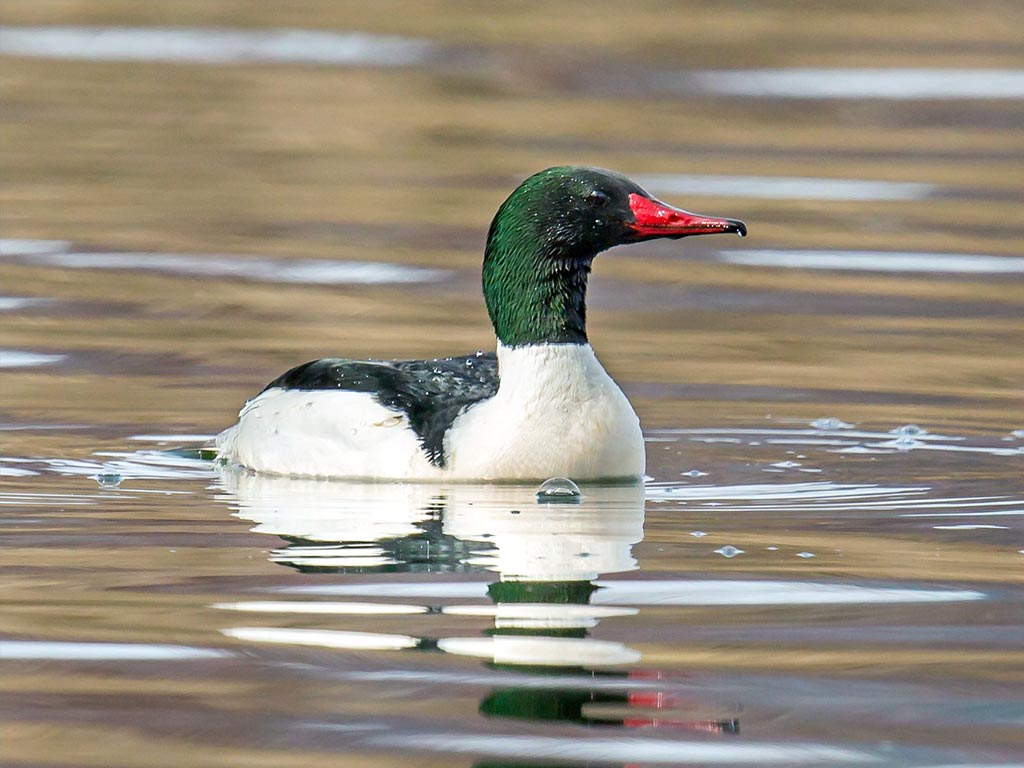
The Common merganser, also known as the goosander in Eurasia, is a notable seaduck found in river and lake habitats of forested regions across Europe, Asia, and North America.
This large bird primarily feeds on fish and is known for nesting in tree holes. It was first described by Carl Linnaeus in 1758 in the 10th edition of his Systema Naturae.
With its distinctive appearance and adaptability, the Common merganser is a fascinating species that has captured the attention of bird watchers and ornithologists alike.
Scientific classification:
| Kingdom | Animalia |
| Phylum | Chordata |
| Class | Aves |
| Order | Anseriformes |
| Family | Anatidae |
| Genus | Mergus |
| Species | M. merganser |
Also Featured In: Flight Birds You Should Know, Birds Commonly Found in Northern California
50. Northern Flicker
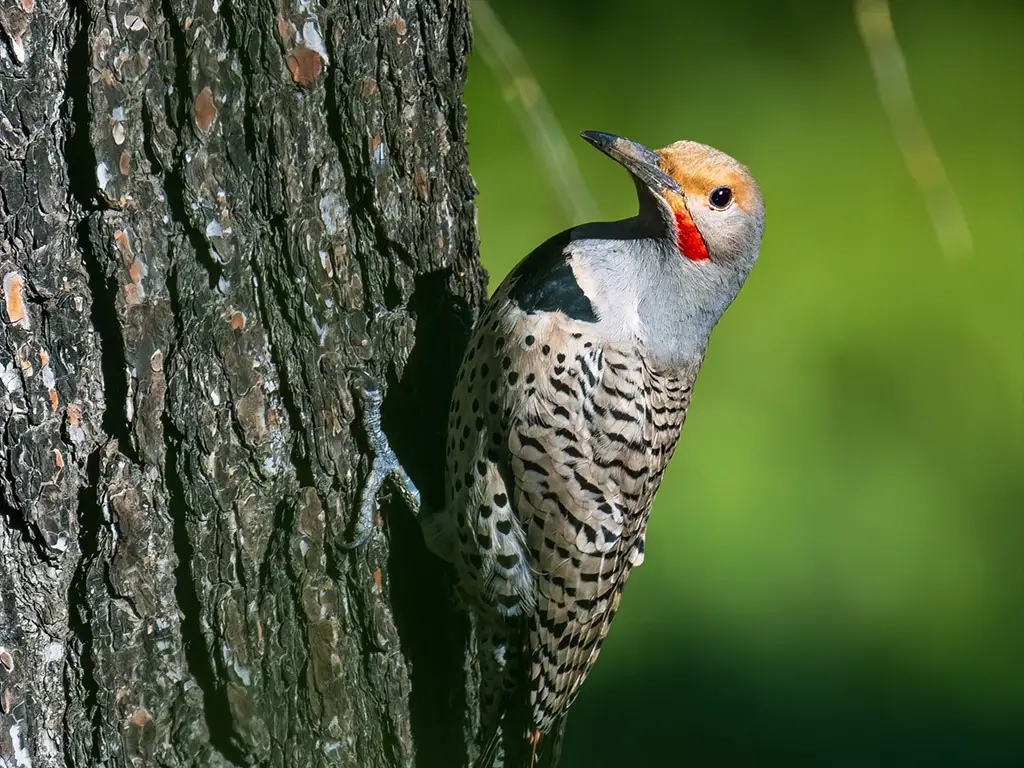
The Northern flicker is a woodpecker species found in North America, Central America, Cuba, and the Cayman Islands. This medium-sized bird is known for its unique migration behavior.
Over 100 common names are used to refer to the Northern Flicker, one of them being “yellowhammer”. It is a beautiful bird with distinctive markings and colorful plumage.
The Northern flicker is an important species in its ecosystem and plays a key role in maintaining a healthy balance in the environment.
Despite being a woodpecker, the Northern Flicker has a diverse diet that includes insects, fruits, and seeds.
It is fascinating to observe this bird as it pecks at trees in search of food, communicates with its unique vocalizations, and performs its incredible aerial displays.
The Northern flicker is truly a remarkable bird species that is worthy of our admiration and protection.
Scientific classification:
| Kingdom | Animalia |
| Phylum | Chordata |
| Class | Aves |
| Order | Piciformes |
| Family | Picidae |
| Genus | Colaptes |
| Species | C. auratus |
Also Featured In: Birds Commonly Found in New York, Birds Live in Arkansas
51. Cedar Waxwing
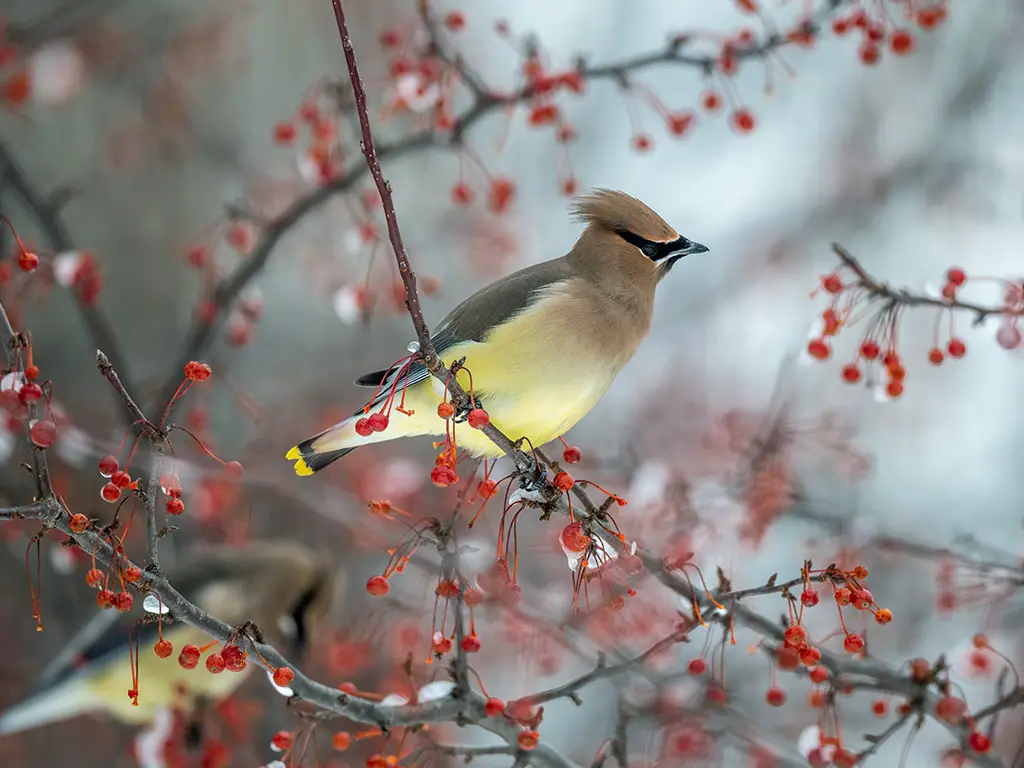
The Cedar waxwing, also known as Bombycilla cedrorum, is a medium-sized bird found in North and Central America.
They have a mixture of brown, gray, and yellow feathers on their body, and their wings have wax-like tips.
These birds prefer open wooded areas in Southern Canada for breeding, and during winter, they migrate to the Southern part of the United States, Central America, and the far.
The Cedar waxwing is a member of the waxwing family of birds or Bombycillidae family.
They are known for their distinctive crest on their head and a black mask-like area around their eyes.
These birds are social creatures and can often be seen in large flocks, sometimes even intermixing with other bird species.
Their diet consists mainly of fruit and insects, and they are important dispersers of fruit seeds.
The Cedar waxwing bird is a beautiful and fascinating creature to observe in the wild.
Scientific classification:
| Kingdom | Animalia |
| Phylum | Chordata |
| Class | Aves |
| Order | Passeriformes |
| Family | Bombycillidae |
| Genus | Bombycilla |
| Species | B. cedrorum |
Also Featured In: New Hampshire Birds You Should Know, Central Texas Birds
To Recap
The province of British Columbia is home to a rich and diverse avian population, with approximately 51 unique bird species found in its varied ecosystems.
From the majestic bald eagle soaring along the coastlines to the vibrant plumage of the western tanager in the interior forests, these birds contribute to the natural beauty and ecological balance of this Canadian province.
They also offer opportunities for birdwatching enthusiasts and researchers to appreciate and study the fascinating world of avian life.
Preserving their habitats and conserving these species is not only essential for their survival but also for maintaining the ecological integrity of British Columbia’s stunning landscapes.